 Remember!! Comment at the end (below the blog box where it says in little blue letters, “comments” click on that and it takes you to comments and a comment box) in order to enter our giveaway. Drawing is Feb 13th. This time TWO people win one of the two identical packages – Pie tin set and First Out Pie Spatula. So comment early and comment often because every single time you comment, your name goes into the pot!! 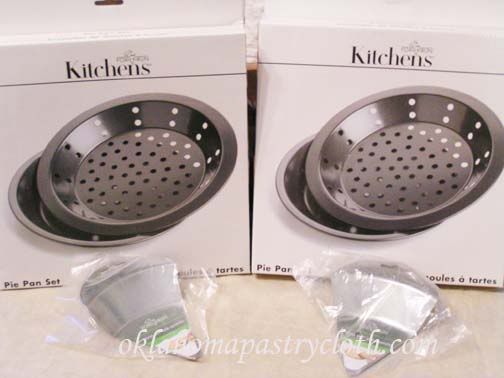 In my last post, I was waxing a bit philosophical and I discussed my understanding about finding joy in the mundane stuff even when things don’t seem all that great. I told you that I had discovered that joy is an attitude of choice. And as I have been contemplating that state of being for the past few months, I have also discovered another attitude of choice: Contentment. Now, I looked up that word and there are a number of definitions with lots of educated descriptions, but as I have been thinking about it, I’ve come up with my own explanation of the state of “contentment”. As I see it, a life of contentment is a life without resentment. Heh..that kinda rhymes, doesn’t it?! It means gracefully allowing the stupid driver who cuts in front of you to be wrong or the store manager trying to stiff you out of a return to be dumb or a lady with a fur and fancy car to be rich or a long-haired youth, marching with a sign to be vocal. In other words, it means, “being satisfied with one’s self and one’s situation, not comparing one’s self to anyone else or expecting others to live up to one’s perception of fairness.” It hasn’t been that long ago that I was in a state of poverty according to that government definition. That’s a whole ‘nother story in itself, but the gist of it is that we had very, very little money. The strange thing is that I never felt poor. I honestly felt blessed and it could have been that I was in a very small town with other people in the same boat, but some of my friends were very wealthy too and so I should have felt like maybe life was lacking something. But I didn’t. And I think that it is because I had discovered the verse in Phillipians 4:12 that says, “I have learned the secret of being content in any and every situation, whether well fed or hungry, whether living in plenty or in want. I can do everything through him who gives me strength.” I had lived in abundance and then I was poor but that state only dealt with money and contentment deals with the heart. Now, today, I am not rich by any stretch of the imagination, according to those government definitions, either, but I am richer than I was in those days now past. And I have found that more money does not give more contentment. There is always more money than one has at any given time. And it isn’t because the world or the people around me are all behaving themselves and living right lives. That just doesn’t happen. There are people who cheat and steal and even kill, but those people can’t steal my contentment. We are told in Psalm 37:1, “Do not fret because of evil men or be envious of those who do wrong;…Delight yourself in the Lord and he will give you the desires of your heart.” The greatest desire of our heart is to be content in God. No need to be angry that others have made more money or that others have more skills or that others say things hurtful. Contentment means to just relax in that with which God has blessed us and to remember that each of us is so special that we are not like nobody else! And of course, one way I relax in what God has blessed me with is to cook it! There is one way toward a contented tummy and that is with a comforting soup on a cold day like today. This recipe is one that a friend and I made up from top to bottom and has been a secret since the late 70’s (except that the original is in the cookbook at the shopping page!), but I have decided to share it today and I hope you find it to be a blessing! The story behind it is that this friend and I used to treat ourselves on special grocery days in the big city (from the country) by going to a particular restaurant. That was in the days before children. This restaurant was very expensive and since neither of us, being farmer’s wives, had much money, we would order the only thing we could afford – soup and salad. But that was all we wanted because that soup was incredible. Finally, she and I decided to try to figure out how to make the soup. We would eat there and discuss the flavors that we were getting in each bite. We went home and started experimenting and the base of this soup was developed. Then, in later years, I added more ingredients that I thought were missing and the following recipe is the end result. I usually make it with fresh crab, but the canned baby clams work just as well and in the off-season are best used anyway. If you want to use crab, just get some snowcrab, steam it and remove from the shells and chop. I sure hope you enjoy it!! 4 Tbsp butter 1 Tbsp onion, grated 3 Tbsp flour 3/4 tsp salt 1/8 tsp mace 1/8 tsp nutmeg dash of pepper 1/2 tsp. fresh chopped parsley 1 cup canned milk 1 chicken bouillon cube or 1 tsp granulated bouillon 2 cups shredded crab meat or 1 10oz can of baby clams 1 1/4 cup half and half 1/4 cup sherry (if you are using cooking sherry, cut back on the salt) 1/2 tsp lemon zest 1/2 cup finely diced tomatoes 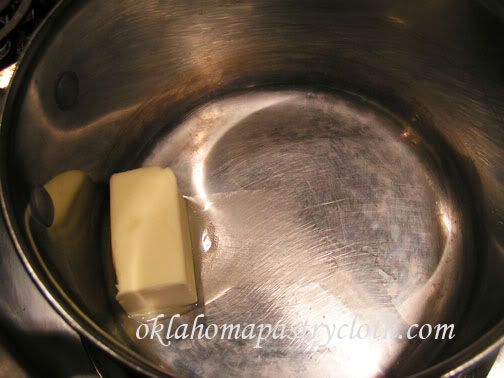 In a large sauce pan on medium heat, melt butter 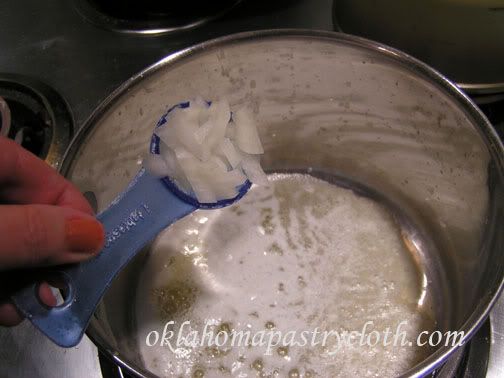 Add onions and saute for 30 seconds 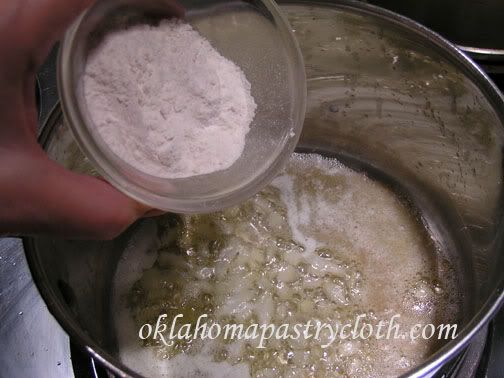 Add flour  Stir to blend and make a bubbling roue  Add nutmeg and mace together and stir 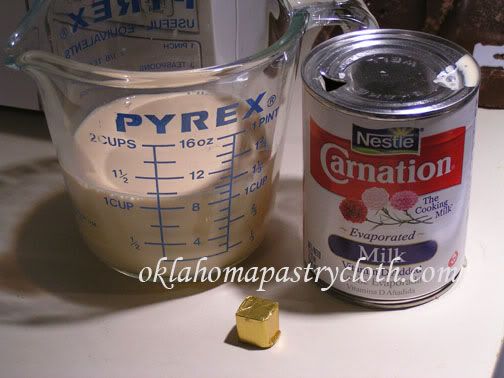 Add canned milk and bouillon. Stir until bouillon is dissolved  Add half and half and continue stirring on medium heat. Do not bring to a boil. Lower heat if the soup is getting too hot. 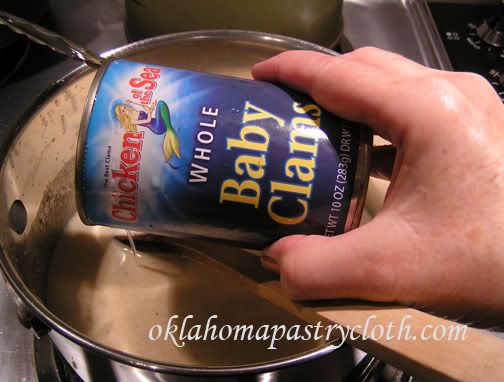 And crab, or in this case a can of baby clams with the juice. 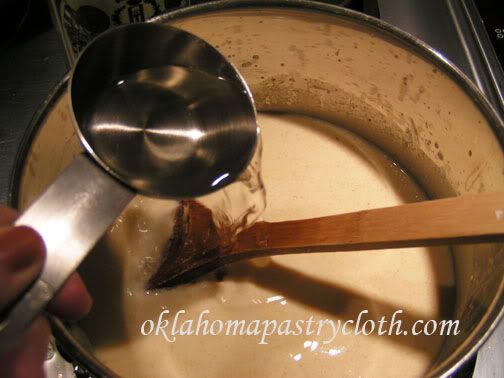 Add sherry and stir to mix well 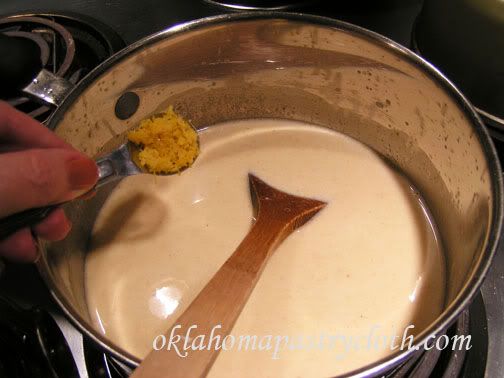 Put in lemon zest 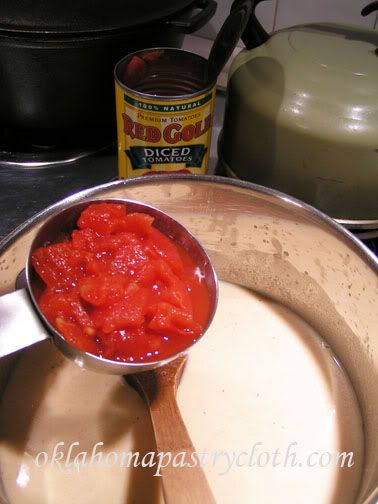 And add tomatoes and stir. Simmer for about 30 minutes, stirring occassionally. 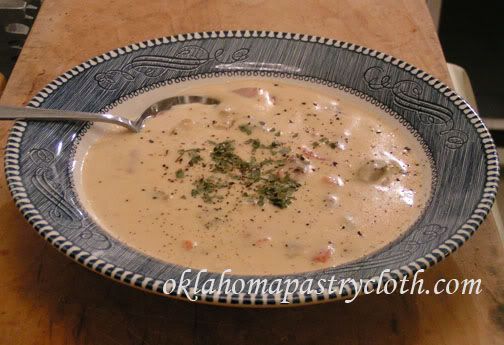 Serve hot and garnished with parsley and black pepper. Yuuuuuummmmmy!! Happy Bisquing! This post is linked at Deborah Jean’s Dandelion House Friday Blog Hop  |
|
|
Oklahoma Pastry Cloth™ Company on Facebook
|
|
 |
|
|
Archive for the ‘Let’s Cook!’ Category
A Tasty Bisque
Thursday, February 9th, 2012
German Cooking
Monday, February 6th, 2012
 Remember!! Comment at the end (below the blog box where it says in little blue letters, “comments” click on that and it takes you to comments and a comment box) in order to enter our giveaway. Drawing is Feb 13th. This time TWO people win one of the two identical packages – Pie tin set and First Out Pie Spatula. So comment early and comment often because every single time you comment, your name goes into the pot!!  Have you ever had one of those days where washing the dishes is such a chore you just want to walk away and pretend they don’t exist?! Today started out as one of those days for me. I was tired when I got up today. Have no clue why – just tired. However, this morning, as I walked into the bedroom and contemplated the as yet unmade bed, a thought swept over me and I had to smile. “Consider it pure joy, whenever you face trials of many kinds, because you know that the testing of your faith develops perseverance. Perseverance must finish its work so that you may be mature and complete, not lacking anything.” James 1:2-4 4 boneless pork chops or 1 lb boneless pork roast sliced to 1/2″ slices or pork cutlets that have been tenderized at the store 1/4 cup flour 1/2 tsp garlic powder 1/8 tsp thyme 1/4 tsp freshly ground black pepper 1 egg, beaten 2 Tbsp milk 3/4 cup fine dry bread crumbs – make your own with a couple of slices of bread toasted and ground in the blender 1 teaspoon ground paprika 2 Tbsp canola oil or olive oil + 1 Tbsp butter 3/4 cup chicken stock 1/2 teaspoon dried dill or 1 Tbsp fresh chopped dill 1/2 tsp salt 2 tsp corn starch 1/2 cup sour cream or 1/4 cup sour cream + 1/4 cup yogurt 1/4 tsp onion powder 1/2 cup sliced mushrooms (optional) 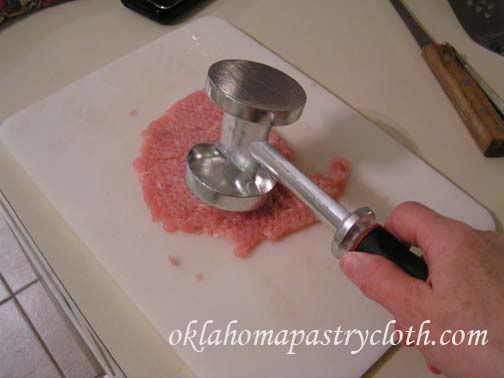 Trim fat from chops. Using a meat hammer, pound the pork chops to about 1/4″ thickness. Make sure edges are hammered nice and flat. 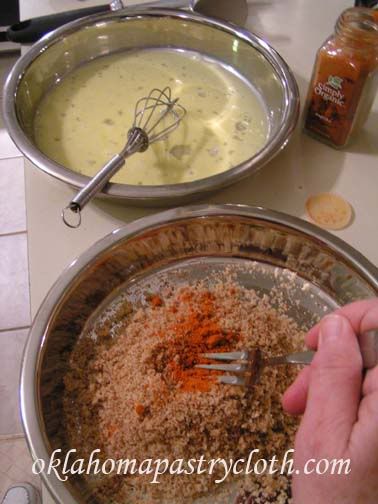 Mix egg and milk in a shallow dish and beat. In a separate shallow dish, mix bread crumbs and paprika and stir to blend. 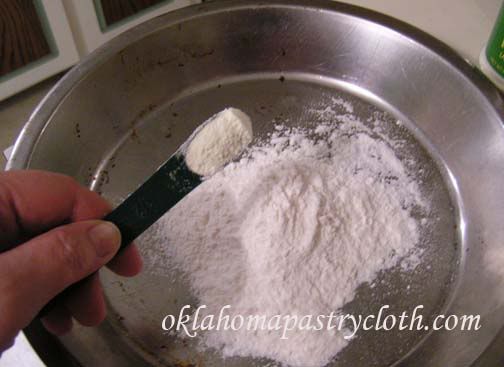 In a third shallow dish (I use pie and cake pans), add garlic to flour 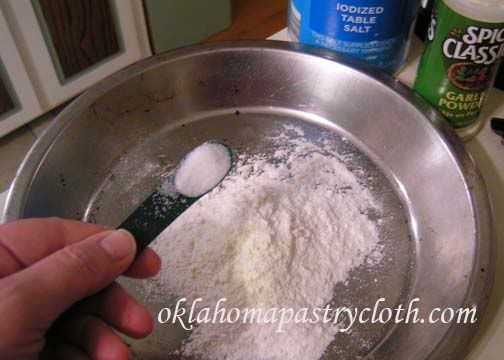 Add salt 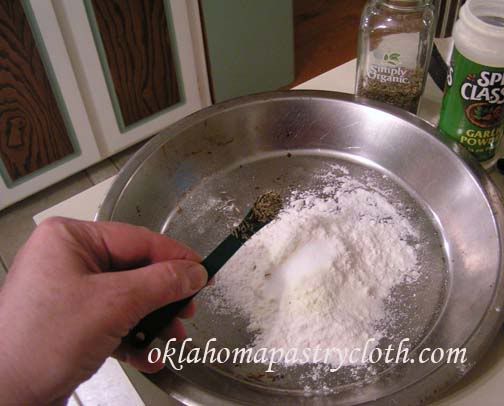 And thyme..mix to blend 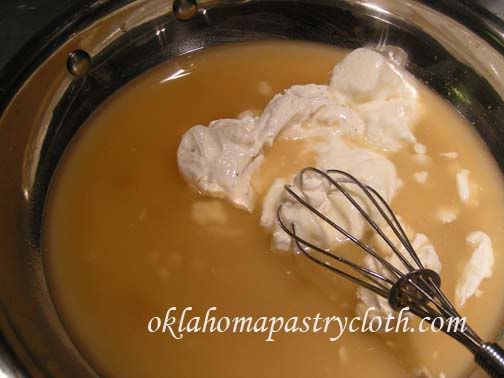 Meanwhile, in a sauce pan or skillet, mix chicken stock and cornstarch and bring to a slow simmer. Add sour cream and onion powder and whisk until creamy. Add mushrooms and stir (if using) Continue simmering. 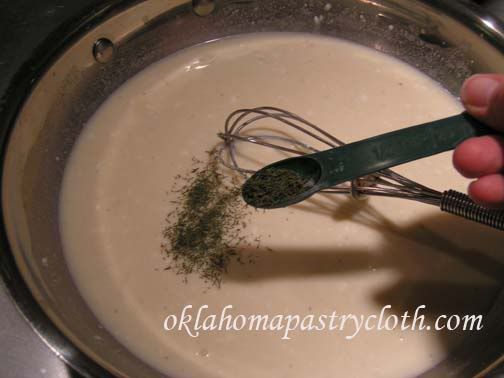 Add dill 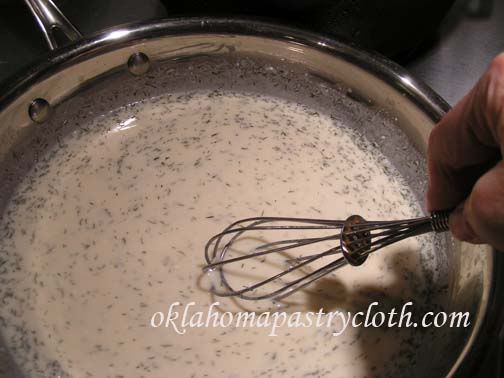 Stir until mixture is thickened to a gravy. Cover and leave on warm 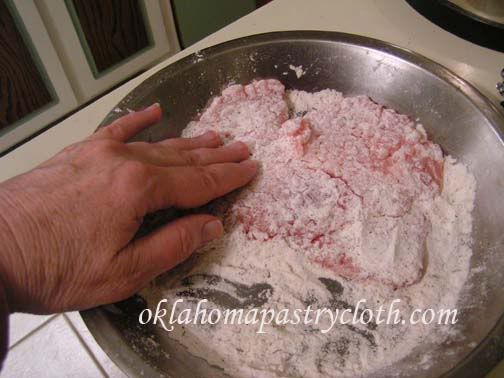 Working with one piece of meat at a time, dredge cutlets in the flour mixture to coat both sides.  Dip into the egg mixture on both sides  And coat with the bread crumbs to cover  In a skillet, melt the butter with the olive oil or canola oil and heat on medium high heat. When oil is nice and hot, add cutlets. Brown and allow to cook about 3-4 minutes. 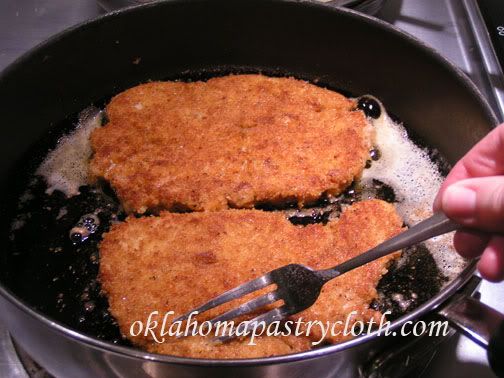 Turn cutlets and brown on the other side and cook for another 3 to 4 minutes. 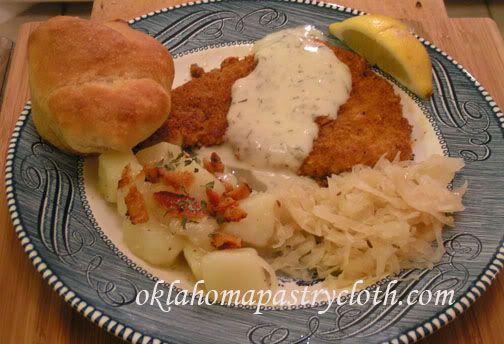 Place Schnitzel onto plates and drizzle gravy down the center. Add a lemon wedge for squeezing juice over the schnitzel. Serve with German potato salad and warm kraut. Of course, a homemade roll on the side isn’t anything to sneeze at!! Happy Cooking!  |
|
|
Oklahoma Pastry Cloth™ Company on Facebook
|
|
 |
|
|
Nutrition In A Roll
Friday, February 3rd, 2012
 Remember!! Comment at the end (below the blog box where it says in little blue letters, “comments” click on that and it takes you to comments and a comment box) in order to enter our giveaway. Drawing is Feb 13th. This time TWO people win one of the two identical packages – Pie tin set and First Out Pie Spatula. So comment early and comment often because every single time you comment, your name goes into the pot!!  Growing up, my parents demonstrated to us girls about the precious gift of “hospitality”. Mom and Dad were ready and willing to open our home to anyone who needed a hot meal or a place to stay. Most of the time, that included students from other countries who were attending the university in our town, which was also my father’s place of employment as a professor. From these visits by young people from all over the world, we girls were introduced to new foods and treats that were authentically cooked or, in the case of the treats, provided from stores overseas.  I remember one of the young women, with whom we became very attached, Mitchiko Kawase, loved to tease us and presented us with a bag of little, dried squares that she encouraged us to try. The squares were dark and salty and as we took a taste, she giggled and told us that it was dried octopus. All of us squealed in horror and she laughed hilariously as she told us that it was really seaweed. I’m don’t remember that we were all that much more impressed! One Japanese food that I love is sushi. I’m not a fan of the raw fish type – more the California roll type – but I put all kinds of stuff in mine and chow down. Mr. Fix-It uses a fork and I use chopsticks. He thinks I’m pretentious! I just think I’m being disrespectful if I use a fork. I thought that in the second of these three posts on some international dishes, I thought I’d share my sushi-making. And you don’t need one of those $19.95 jobs as seen on tv!  You can use a rice cooker or a pot to make your rice. For three large sushi rolls, make three cups of rice. Sushi rice is different from regular rice. It is much stickier. I use a type called Hanmi but you can go to any specialty store and many larger groceries and ask for sushi rice. 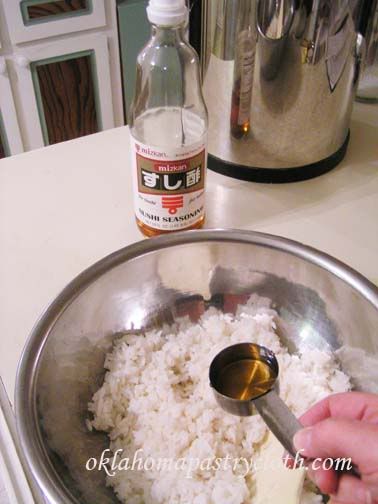 Once your rice is cooked, put it into a large bowl. A bamboo bowl is great too. Add two tablespoons of sushi vinegar to the rice. Sushi vinegar has sugar in it and is slightly sweet/sour. 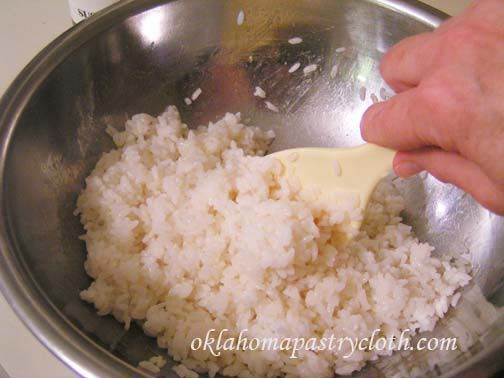 Toss the rice to evenly distribute the vinegar 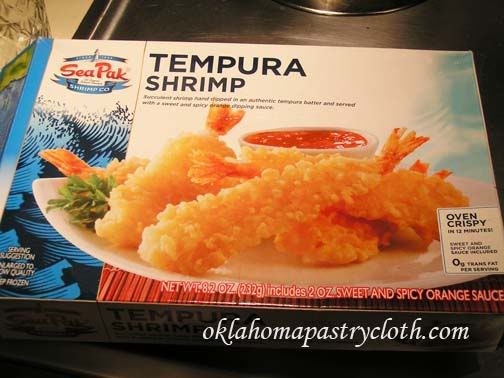 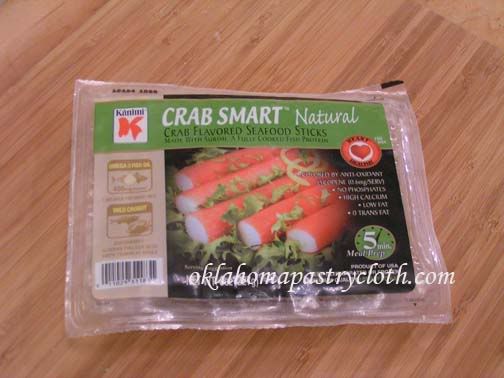 There are any number of proteins that can be used in sushi. Here, I am using a tempura shrimp and Crab Smart. You can also use scrambled egg that is sliced, fresh crab, salmon, cream cheese and the list goes on. And there is no limit to the veggies! Anything goes. 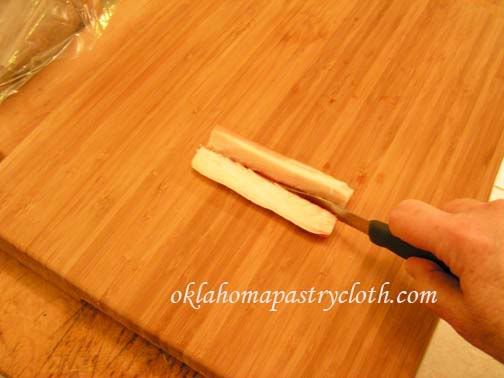 The crab sticks are too thick and so I cut them in half. 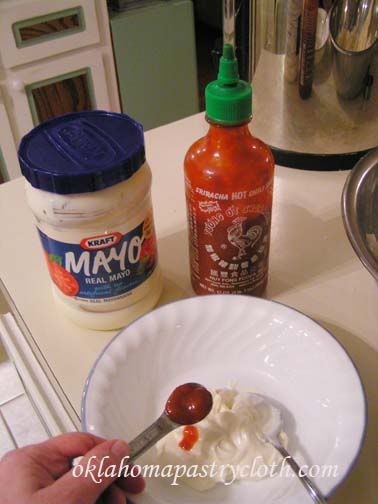 I make a sauce that I will use over the sushi by mixing 1/3 cup mayonnaise with 1 teaspoon Chinese chili sauce. 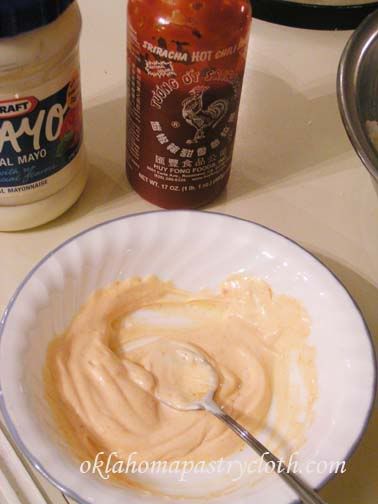 I mix until smooth and creamy 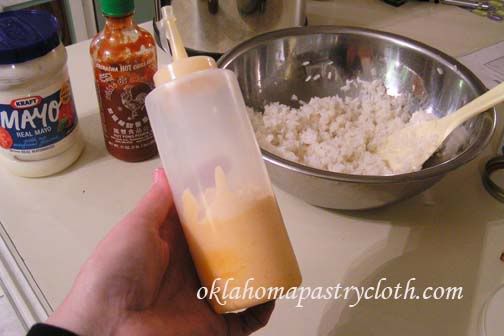 And put the sauce in a squeeze bottle like is used for mustard or ketchup. This gives me a nice little bead to design on the sushi rolls. 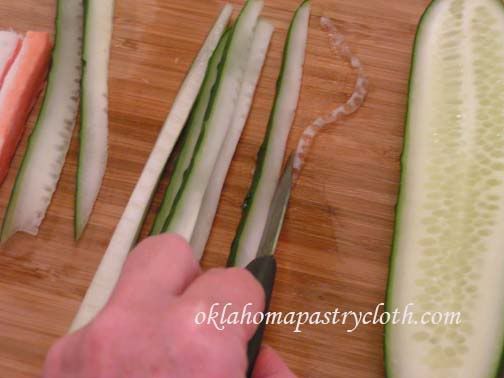 I use cucumbers and slice them into 1/4 inch thick slices and cut off the seed area 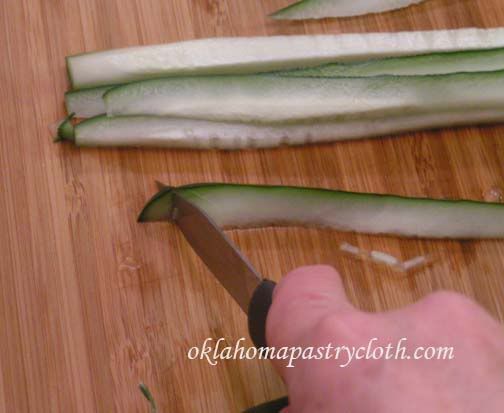 I square off the ends of each slice 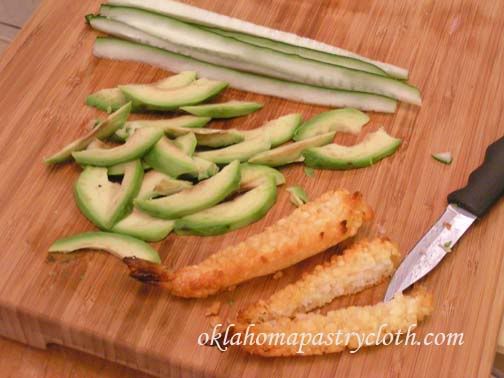 I also slice the shrimp in half after baking it and also slice up an avocado.  A sushi mat is made of either flat bamboo slats laced together with twine or with round sticks laced together as well. I like to use Press and Seal on my mats because it keeps them clean instead of pressing rice down between the gaps.  Sushi Nori is actually kelp seaweed and is full of iodine and is one of the highest plant sources for calcium. It is also chocked full of other vitamins and minerals. Some people toast their nori prior to making sushi by spraying a skillet with a light layer of oil, heating and then placing a nori sheet on the skillet for about 30 seconds and then turning. Others just use the nori straight out of the package.  Place the nori on the mat with the narrower end parallel to the lines of the mat 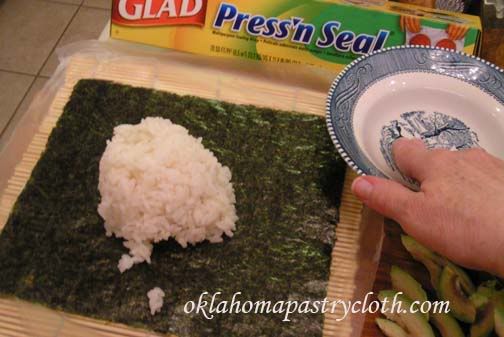 Place 3/4 to 1 cup of rice on the nori. Place a bowl of water next to your work area. You will want to keep your fingers wet to work with the rice to avoid sticking. 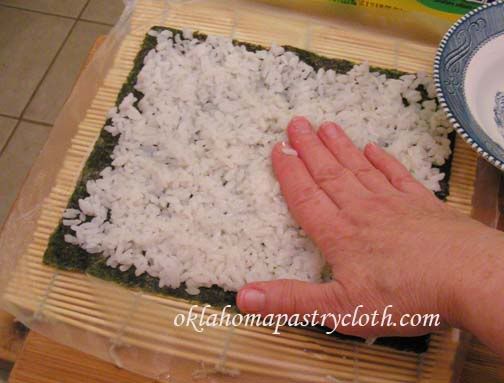 Spread the rice evenly over the nori and press down to make an even surface. 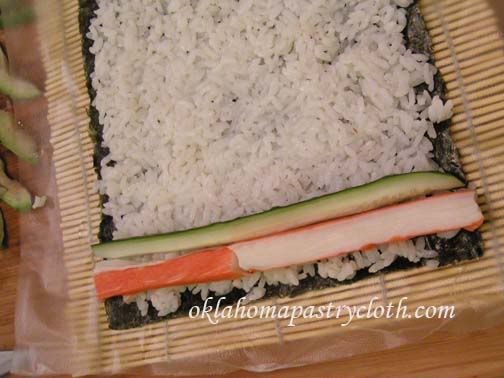 Place crab and cucumber at one narrower end of the nori running parallel to the mat, leaving about 3/4″ of nori showing at the end. 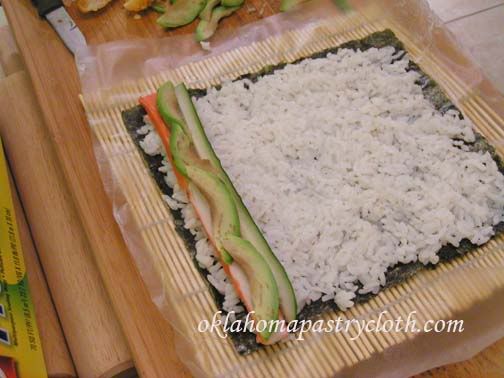 Place the avocado on top of the crab and cucumber 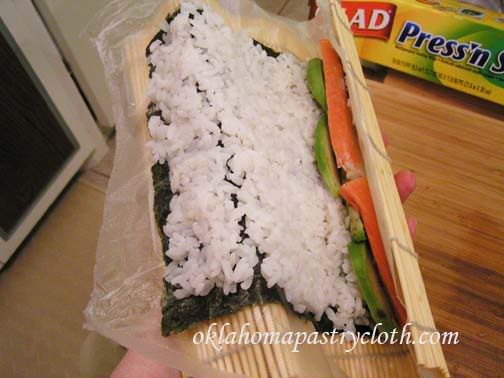 I find it easiest to pick up the roll and start rolling the mat at the end with the filling one full roll and then placing it back onto my work surface to continue 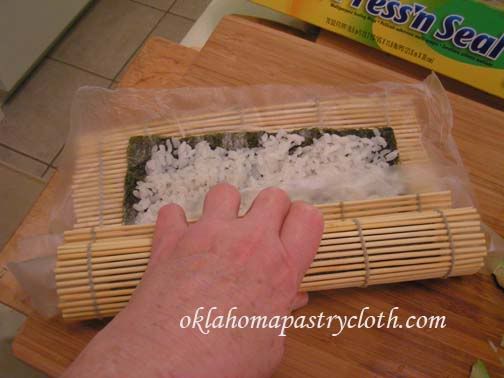 I continue to roll, lifting the top edge of the mat away from the roll so that it does not get rolled up with the sushi. I squeeze the mat with both hands as I go to keep the roll tight. 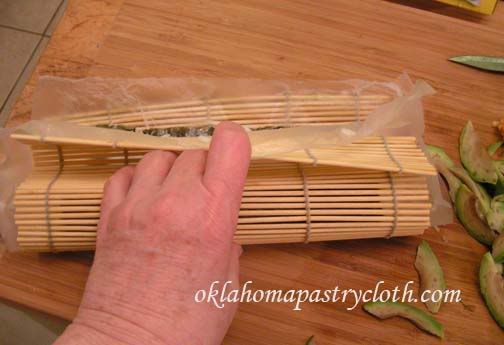 I am lifting the top side of the mat with the Press and Seal away from the roll as I continue to roll. 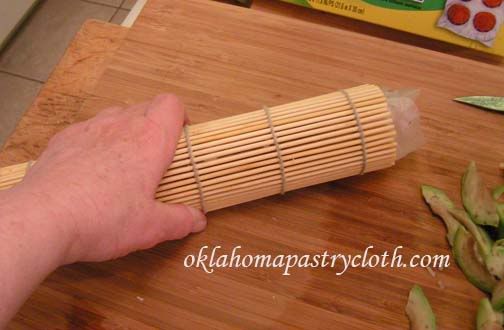 I continue to tighten the roll  And Voila! There’s my sushi roll. 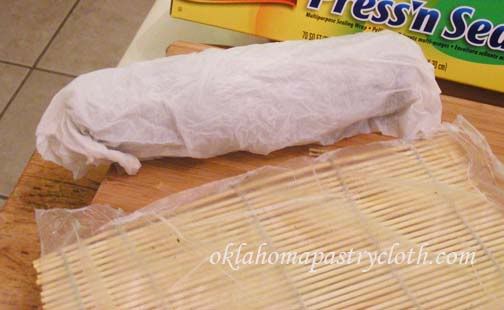 I wrap it in a wet paper towel and set aside as I continue to make more rolls. 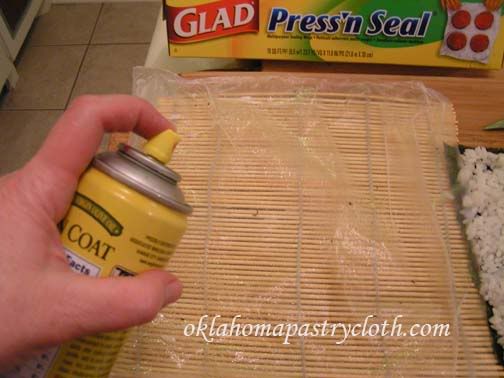 Now then, you can have the rice on the outside of the roll instead of the nori showing outside. And to do that, first I do the first steps of putting rice on the nori and patting it out and then I lift the nori and rice from the mat and set it aside. I spray the Press and Seal with a little olive oil. 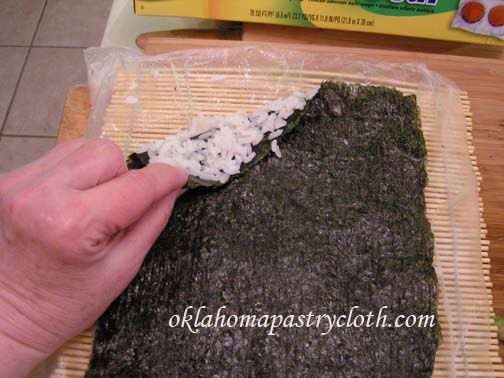 Now, I place the rice package with the rice against the press and seal and the nori on top – basically upside down from the first way I showed you. 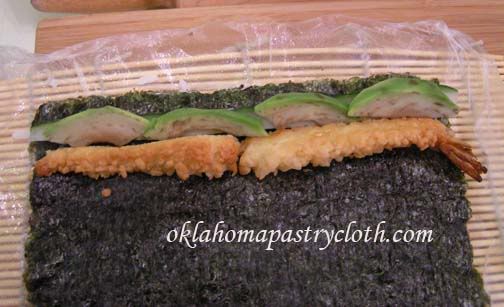 I add my center, this time using the shrimp instead of crab 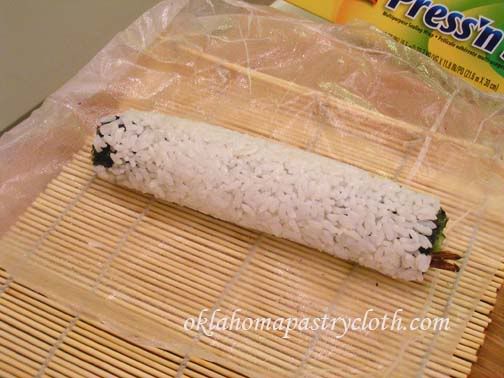 I roll exactly like I showed you above on the first sushi roll and here you have the result  To slice these rolls to get the nice little medallions you see in restaurants, you need a sharp, finely serated knife. I keep my knife wet to cut as well. 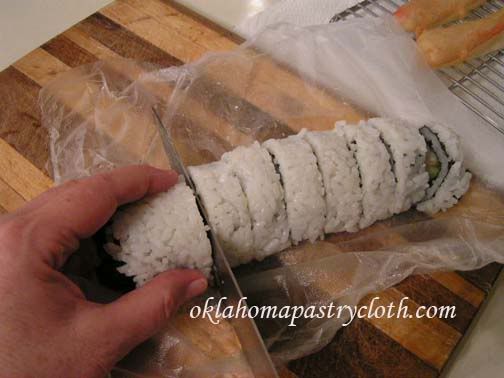 Slicing the roll with the rice outside is a little trickier than when the nori is on the outside. Also, I keep my hands wet so that the rice does not stick. 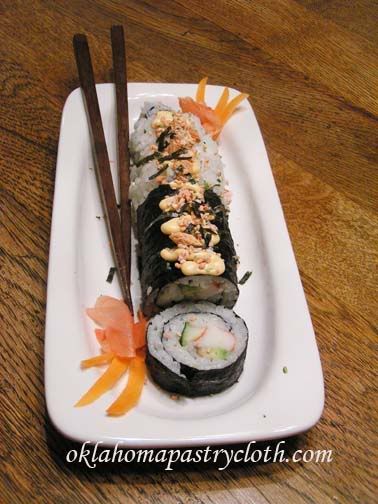 Here are a combination of the two rolls put together. You can see that I squeezed the sauce in a squiggle along the top of the roll and sprinkled with salmon rice seasoning and have carrots and pickled ginger on the side. 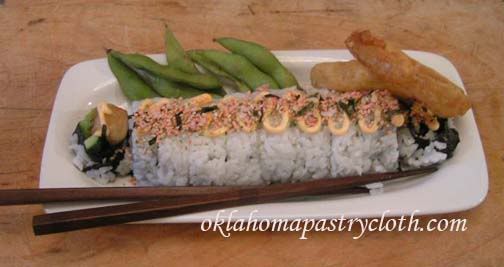 This is a roll that was made with the rice on the outside and is served with edamame and tempura onion rings  Here are a few things you can serve with your sushi – Soy Sauce, Wasabe and Rice Seasoning. I sure hope you won’t be afraid to try making this!! I know it looks complicated, but really, it goes very quickly and you sure will love the results!! Happy Trying Something  |
|
|
Oklahoma Pastry Cloth™ Company on Facebook
|
|
 |
|
|
Homemade Tamales
Monday, January 30th, 2012
 Before I get started here, I want to remind all of you to be sure and comment at the end (below the blog box where it says in little blue letters, “comments” click on that and it takes you to comments and a comment box) in order to enter our giveaway. This time TWO people win one of the two identical packages – Pie tin set and First Out Pie Spatula. So comment early and comment often because every single time you comment, your name goes into the pot!!  And now, I’ve written in the past about dumb things I’ve done to which I actually admit. I like to think of myself as a normal human being with a modicum of quirks and I am willing to admit – to an extent – what are those quirks. My children read this too and I can’t admit everything as my “perfect mother” status might fall in their estimation. Oh? I ain’t all that perfect in their eyes? Huh. What a surprise. I’m thinking that the time I went to an Atlanta church for my girlfriend’s wedding, was escorted down the aisle to be seated on the bride’s side, and was handed a ‘program’ only to discover that the couple being married WEREN’T my girlfriend and her fiance, probably tops the stupid things I’ve done. Skulking back down the isle and out the back door was humiliating enough, but then finding out that the wedding had been in Murfreesboro, TN just cemented my stupidity. Well, this weekend, I proved to Mr. Fix-It that it is possible that I’m a few gummy worms short of a bag. He was very kind about it, but I really think he was looking for those lost gummy worms. He was really hungry after my flirtation with brain freeze. You see, we had been invited to a wonderful SURPRISE party for our dear friend, Jeff, who was turning that ripe, old age of the big 5-0. The invitation was presented as a cute poem with the date and the location – the nearby church. As it so happened, my birthday was this past week as well – and I turned much older than the big 5-0 – and so, for some reason, the week just got kind of discombobulated. (like that word? – fits the week) Since I had promised to provide a snack of substance for Jeff’s party, I made plans for making a large batch of oriental sweet and sour meatballs. No party is a party without meatballs, don’t you know?! On Saturday, I spent the day putting together several batches of my homemade sweet and sour sauce, cooked meatballs, added sauce and pineapple chunks and piled those into a crockpot on low to keep them warm. I pushed Mr. Fix-It to leave the love of his life, Ellie (our mini long-haired dachshund), to get out of his jeans and into newer jeans so that we could at least appear as decent as that couple in the painting, American Gothic. I grabbed the meatballs and we headed to the church. Seeing a couple in the front entry of the church, I carried my meatballs up to the lady and inquired about which room was sponsoring Jeff’s party. She looked at me with kind of a half smile and choked back a laugh as she informed me, “Jeff’s party? That was last night, honey.” Well, great. And so, the meatballs went to Jeff and his family that night, as I crawled to their door in total humiliation. No birthday present is complete without meatballs. In order to repair my reputation, I have decided to prove that I CAN do something right and so I think I’ll do these next three posts with some international recipes that will wow your family and guests and that are not your usual fare. The first two are a family staple for us. The last one is a newer recipe for me. Today, we will start with homemade tamales – one of Mr. Fix-It’s favorites. The nice thing about tamales is that if you are willing to take a Saturday afternoon to cook, you will wind up with enough tamales for quite a few meals. The extras can be frozen or canned. So get your pork roast ready and follow the directions below: 2 lbs boneless pork roast, or boneless chicken breasts or boneless beef roast 1 tsp ground cumin 1 tablespoon chili powder salt to taste 1/2 tsp garlic powder 1/2 onion finely chopped water Masa Harina Dough 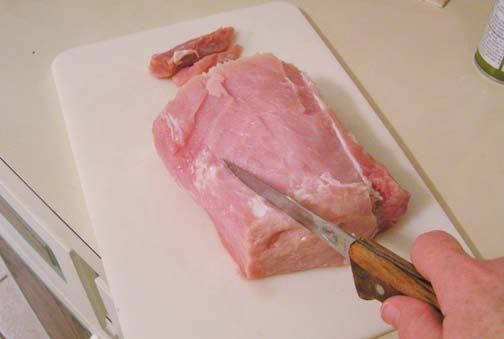 Cut roast into cubes and place into a large pan, just cover with water and bring to a boil on medium-high heat. 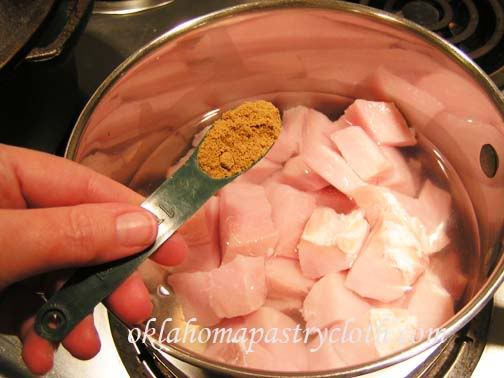 While heating, add cumin  Add chili powder  Add salt according to your taste 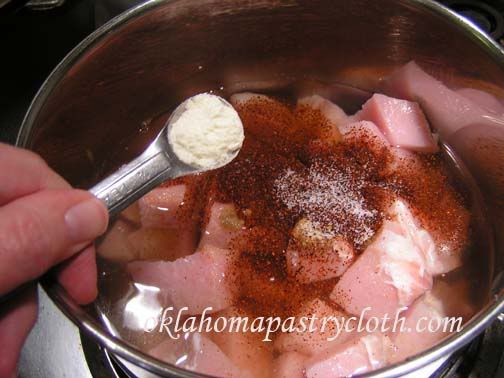 And add garlic. 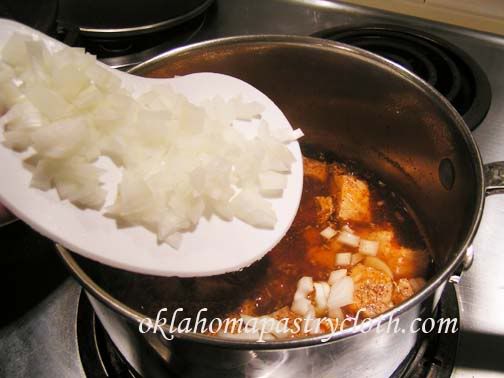 Add onions and stir. Boil for 30 minutes.  Place the meat into a covered casserole dish or dutch oven and place into a 350º oven to bake for about an hour to an hour and a half or until meat is very tender and comes apart easily. 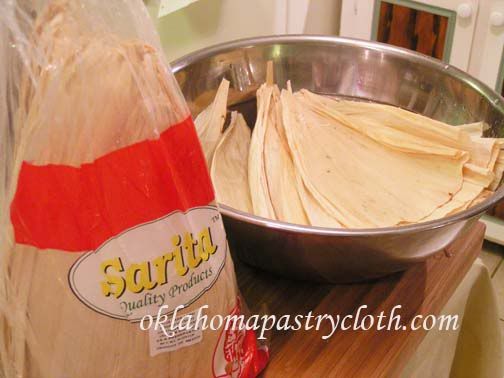 While the meat is cooking, soak corn husks in very warm water. You can find these at any grocery store in the international food section or in the produce section. Some of our stores even have them hanging on endcaps. 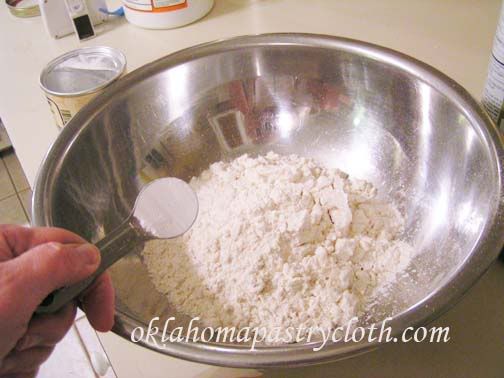 In a large bowl, mix masa flour with baking powder and salt. Set aside 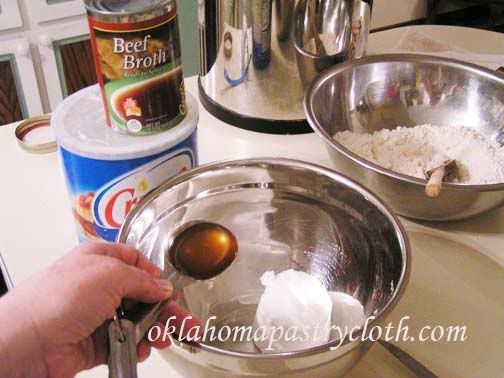 In another bowl, mix shortening with 1 tbsp of the beef broth. 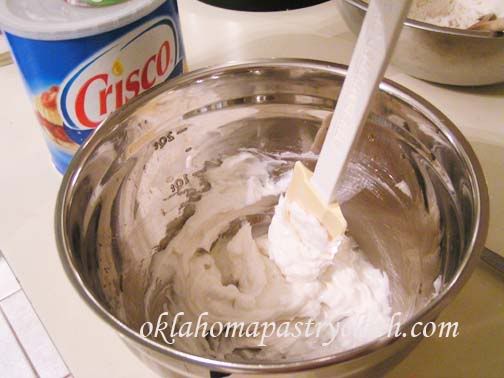 Beat broth and shortening until you have a fluffy mixture  Add the shortening mix to the masa mix  Cut in shortening mix. Add more beef broth, stirring, to form a spongy dough. 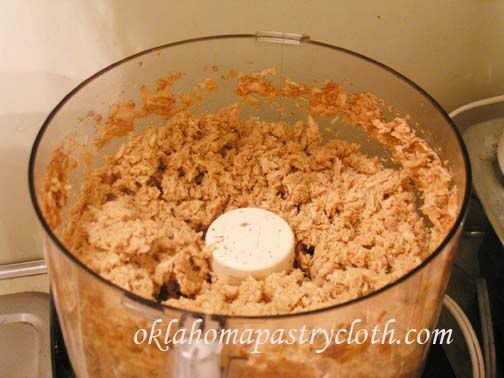 Either shred the pork with a fork or put it into a food processor for a finer shred. (Mr. Fix-It like’s it “pre-chewed” shredded.  Press dough onto center left side of a corn husk, a little under 1/4″ thick. This is the way I like to roll them because it makes allowances for short or misshappen husks. However, if you want to make your tamales in the traditional rectangle, move the square of dough down to one end and to the left side. 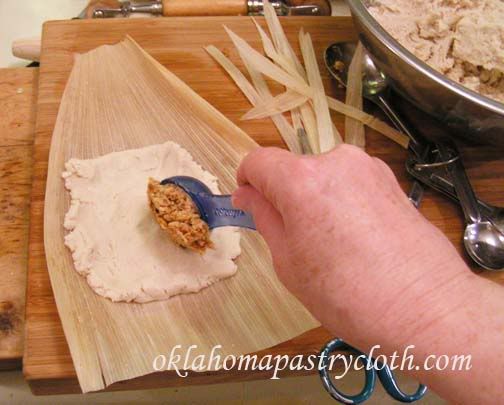 Place at least a tablespoon of meat onto the center of the dough. 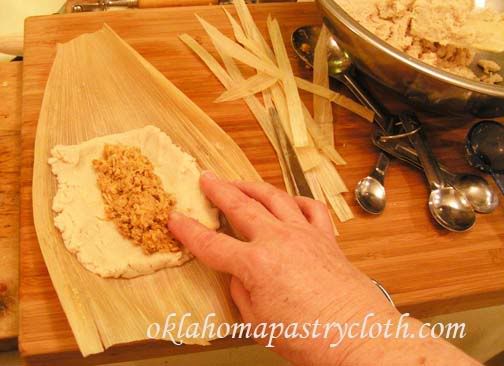 Spread the meat out into a long rectangle down the center of the dough 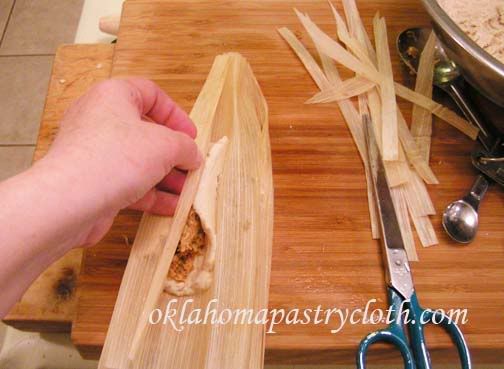 Roll tamales by moving the left side toward the right and rolling until right empty husk is covering the seam of the right side. If doing the traditional flatter tamale, you will still roll the same way. 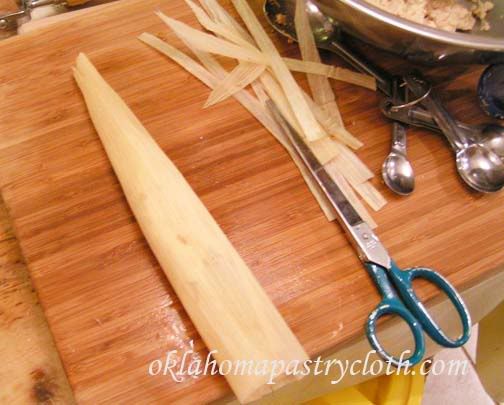 Rolled tamale 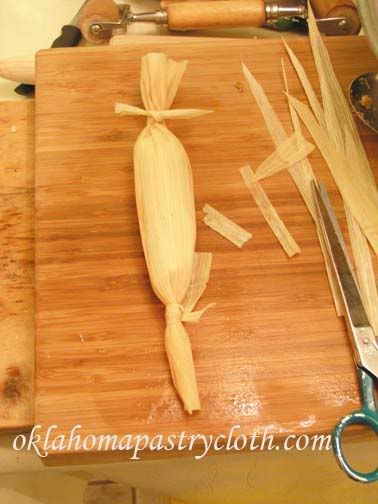 I tie the two ends with strips of corn husk, but if you are doing the flatter ones, you will fold the empty half of your corn husk over the full half of the corn husk roll and tie around the middle with a longer strip of cornhusk. 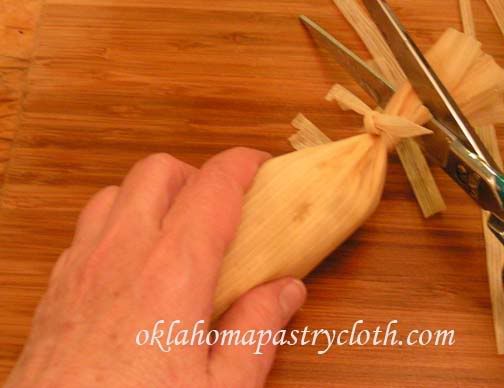 Clip the ends of the tamale to shorten. 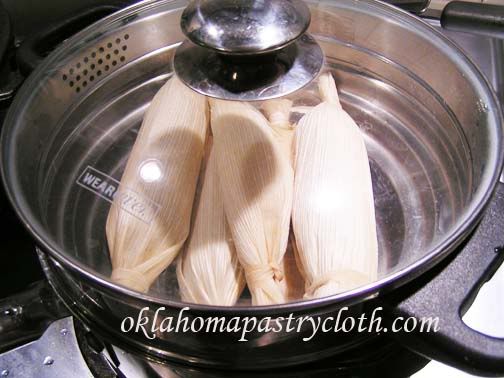 Steam tamales for 45 minutes to an hour (depending how many you are serving). Freeze unsteamed extras in a freezer bag. I will show how to can them in another post.  I only serve 5 tamales for our meals – two for me and three for Mr. Fix-It. We love ours with my canned, homemade chili, heated and served over the tamales and topped with lots of cheese – and sour cream and guacamole if we are feeling really daring! Happy Cooking!  |
|
|
Oklahoma Pastry Cloth™ Company on Facebook
|
|
 |
|
|
New Giveaway and Canning Too!
Thursday, January 26th, 2012
 Valentine’s Day is coming up and I’m just thinking it would be the good thing to do to have a giveaway with not just ONE winner, but with TWO winners! And both winners would get the same thing…so since this is a blog that centers an awfully lot on cooking (with a little humor and education thrown in) the most appropriate prize would have to do with cooking! So, on Valentine’s Day, we will be drawing the name of two winners who will receive a very special pie tin set that includes the tin and then, to prevent shrinkage, a second perforated tin that fits on top of a single crust that is being baked for cream pies. Plus, I am throwing in a “first out pie spatula” that is baked under the pie crust. When the pie is cooled, you slice along the edge of the spatula and, voila!, you lift out that first piece without having to dig. Cool, huh?  So from now until February 13, leave as many comments at the blog as you wish because each time you comment, your name goes into the pot. Just scroll down to the bottom of the post and just below the text box you’ll see in blue “comments” and a number showing how many comments there are. Click on that and it will take you to comments and a comment box. Browse the blog, read and comment and keep your fingers crossed! 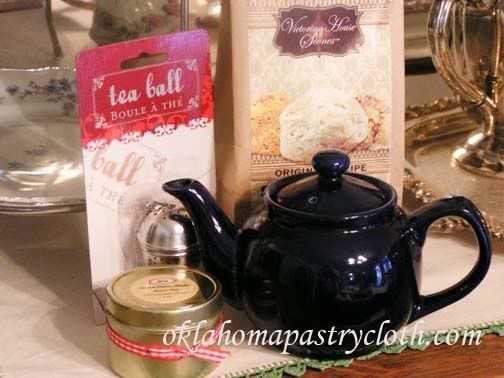 And while I am mentioning Valentine’s Day, I want to encourage you to take a look at the Tea or Tea And Treat of the Month Clubs as perfect and unusual gifts for someone you love. The first month, your loved one receives a ceramic tea pot, a tea infuser and tin of tea and treat and each following month, a new tea flavor and treat arrives. It’s that gift that keeps on giving! In the meantime, speaking of citrus fruits from the last post, I wanted to show you another wonderful citrus product that you can can – Lemond Curd. Wonderful on scones, in tiny tarts and other sweet treats, Lemond Curd makes a beautiful gift to include with dessert mixes. My recipe and directions for Lemon Curd can be found here. Just make up a couple of batches and jump in below: 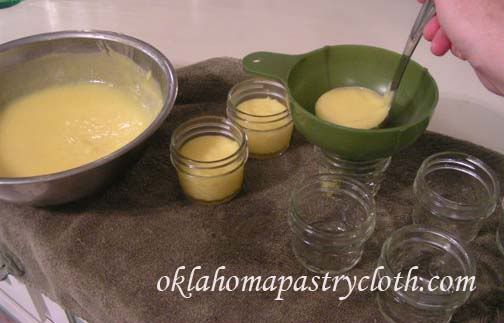 Once lemon curd is made, while still warm, fill sterilized jars to 1/2″ headspace. I use the 1/2 pint and 1/4 pint jars that make wonderful and cute gifts. But you can also use pints. 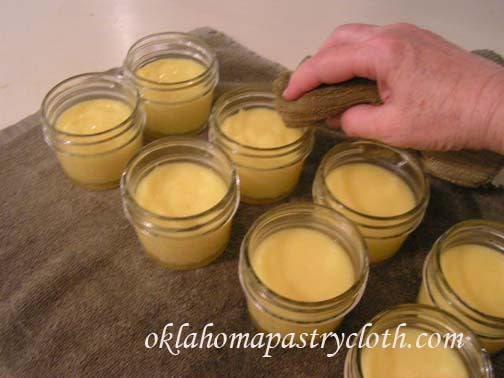 Wipe the rims of the jars with a warm, wet cloth to remove any drips and oils from your hands. 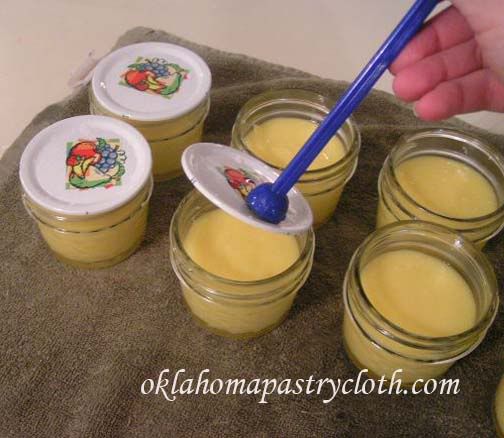 Having warmed your lids in nearly boiling water place them onto the jars. Add rings and adjust. These jars are the 1/4 pint jars great for 4 servings. 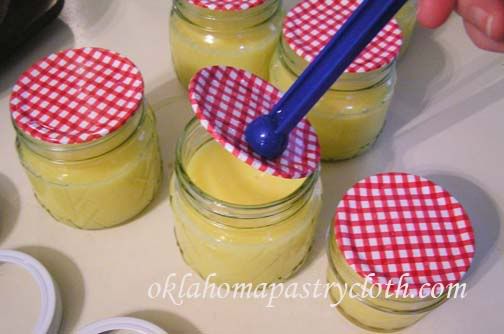 Here, lids are being added to the 1/2 pint size which offer approximately 8 servings each.  Place jars into a waterbath canner and lower into water that is barely warm to cover jars by approximately one inch of water. Turn eye on high and as soon as water starts to boil, time for 10 minutes of processing. Process for 15 minutes if using pints. 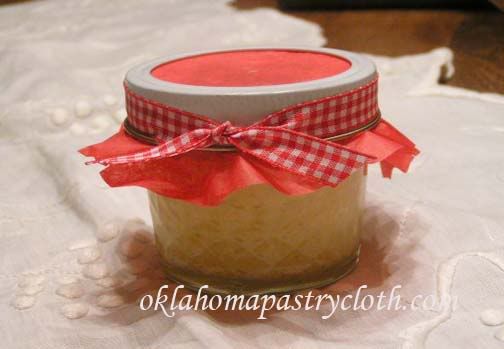 For gifts, decorate the jars with cloth or tissue paper, a label with instructions and ribbon. Add a bag of scones mix and place in a gift bag for a really cute present. Or, jars can be stored in a cool, dark pantry, for your own use. Be sure to refrigerate before opening to serve cold. After opening, the curd may need to be stirred to make it creamy before serving. It’s yummy!! And don’t forget to leave comments to enter the Valentine’s Day Giveaway!! Happy Canning!  |
|
|
Oklahoma Pastry Cloth™ Company on Facebook
|
|
 |
|
|
Canning Citrus Fruits
Monday, January 23rd, 2012
 Boy, today has been quite appropriate for thinking about canning fruits. We are so dry in Oklahoma that I’m having to put a humidifier near my piano to keep the soundboard from cracking!! And today, nearly 50 mph winds stirred up loose dirt from drought stricken fields, sending it airborn, dimming the sun and leaving trees and a horizon with a snow flurry like appearance. It’s pretty certain that a boatload of Okies are thinking back to the days when fruits, vegetables and meats, in glass canning jars processessed when items were in season or available at the stores, were their only defense against starvation during the Dust Bowl days. A very interesting website about the kitchens of that time and of many other eras is The Historic Cooking School where Rena has kindly linked to my posts on vintage cooking. In talking with my dad about those times, he remembers his family buying grapefruit in canning jars and eating this citrus delight because it was not readily available fresh. My family has always been overly fond of oranges, tangerines and grapefruits and when I was growing up we had relatives along the Indian River in Florida which guaranteed us succulent fruit. This year, for Christmas, my parents surprised me with the most wonderful variety of white and ruby red grapefruits, navel oranges and tangerines. There were so many grapefruits that I decided that I had better do something with some of them before they spoiled. In doing research about the history of the canning process, I found this really neat site called Tasteful Inventions where I learned that nearly 250 years ago a French man named Nicolas Appert, encouraged by a 12,000 franc prize issued by the government, introduced his 14-year-in-the-making canning discovery as a way to preserve food for Napolean’s army because, “An army marches on it’s stomach.” Napolean awarded Monsieur Appert the money in 1810. So folks, canning has been around for a long time!!! C’est bon!! I have to say that when citrus fruits are canned, the taste is changed somewhat. Adding sugar or sweetened juices helps to reduce these changes and serving ice cold makes a difference too. Also, it is very important to remove all of the white pulp from any fruit prior to canning because the pulp adds a bitterness that you don’t want. When doing grapefruit, I do not peel and section, but rather slice and use a grapefruit knife to remove sections that easily leaves any pulp behind. Oranges and tangerines are much easier than grapefruits to deal with when peeled. Note: I used half pint jars for single servings, but pints and quarts are fine too. Directions: Place your jars into water to boil for sterilization or run through the dishwasher on sanitize cycle. Place lids into a saucepan and cover with water. Bring to almost a boil and then keep heated. 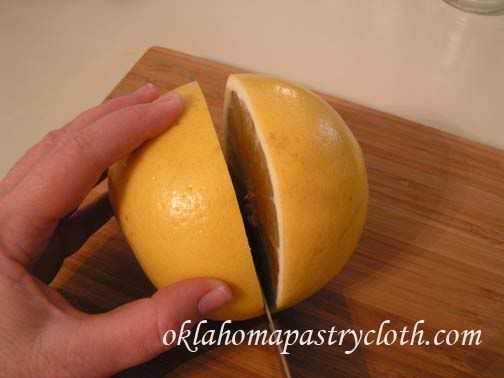 Slice the grapefruits. I used a total of 6 very large grapefruits, both white and ruby red, for this particular project and got 6 half pints. 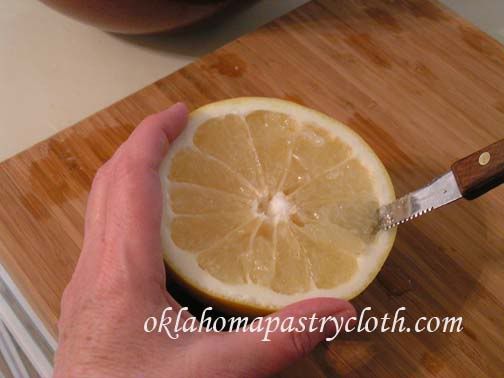 Using a grapefruit knife, which is serrated and curved, cut around each section moving from section to section.  Scoop the grapefruit sections into a large bowl.  Squeeze grapefruit juice from each half into the bowl 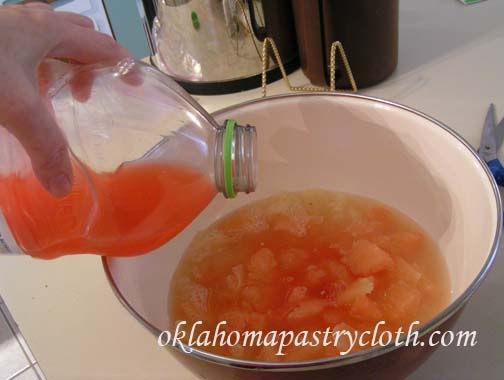 You can make a light syrup with water and sugar, but I like to add real juice that has been naturally sweetened. Any grapefruit juice sweetened with apple juice and white grape juice works great. Add enough juice to cover the fruit.  Using a canning funnel, evenly divide pulp and juice between jars, filling to a 1/2″ headspace. 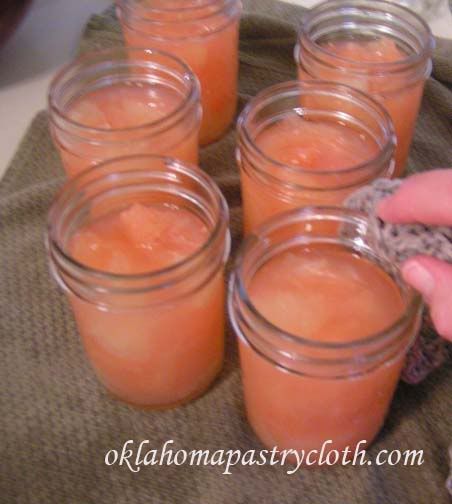 Wipe the rims with a warm, wet washcloth. 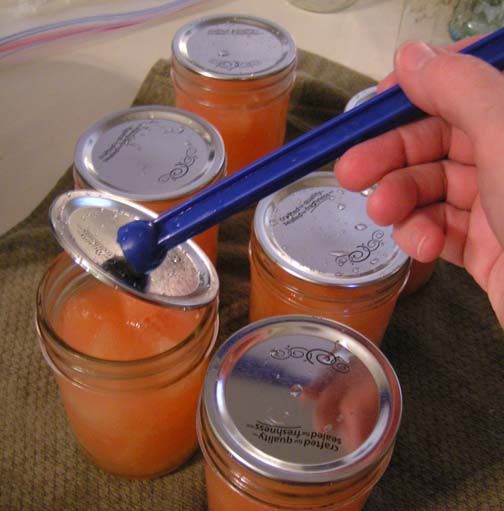 Remove lids from hot water and place onto jars. Add rings and adjust. 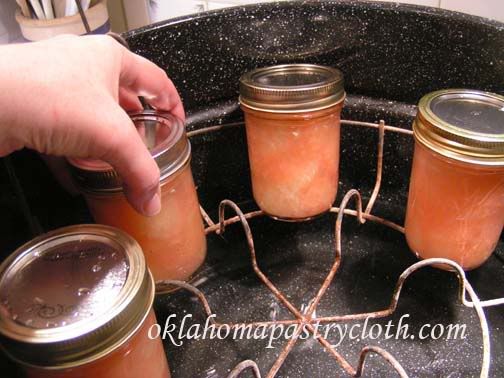 Place jars onto the rack of a waterbath canner that is sitting on a burner and has only slightly warm water in it. Do not place jars into hot water as jars can crack. 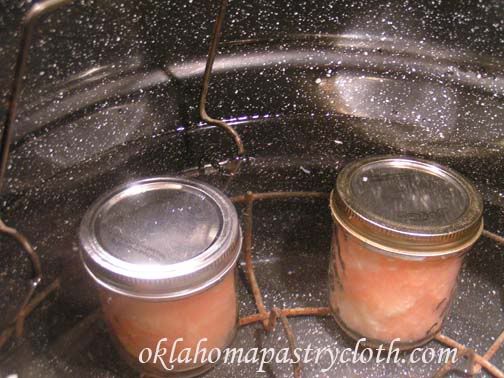 Make sure that the jars are completely submerged with about an inch of water above the lids. Turn the burner on ‘high’. Process the jars for 10 minutes at the point that the water starts boiling. 15 minutes for quarts. Store in a cool dark place and refrigerate before serving. Happy Canning!  |
|
|
Oklahoma Pastry Cloth™ Company on Facebook
|
|
 |
|
|
Vintage Cooking Pt IV
Thursday, January 19th, 2012
 That is the title of the last section of recipes, regarding meats, in Austin’s Domestic Science Books 1 & 2, my grandmother’s 1914 home economics book. I thought that, as the last installment in this line of posts, it would be fun to share some of this information from the past and give you a little bit of history. 2 cups flour 4 tsp baking powder 1/2 tsp salt 2 – 3 tbsp shortening 3/4 cup milk a quantity of cold roast beef or beefsteak (I used a quart of home canned rump roast) 1/2 onion 1 cup sliced potatoes water to cover potatoes beef stock 2 tsp corn starch salt and pepper to taste If using fresh beef, cut into cubes and cover with beef stock to boil until tender. Slice potatoes and cover with water in a second pot. Parboil for 8 minutes. Drain potatoes 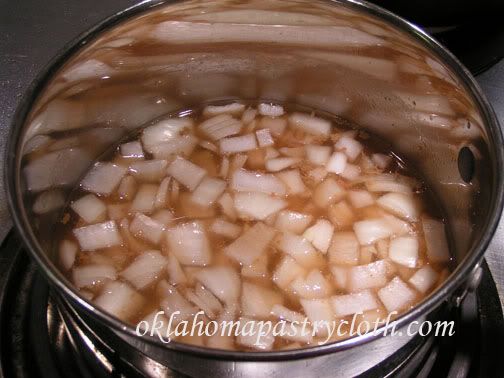 When beef is cooked, strain from stock and add onions to boil.  While onions are boiling, put flour, salt and baking powder into a bowl. 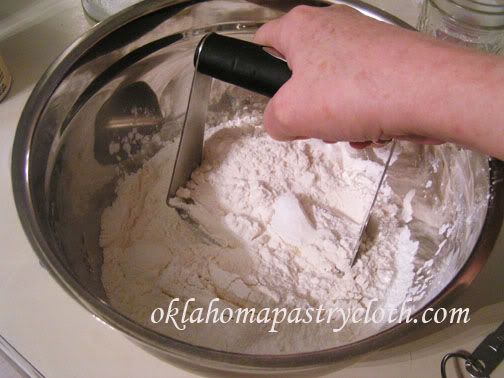 Cut in shortening until it looks like small granules  I used my canned rump roast for the beef. Beef should be tender and shredable. 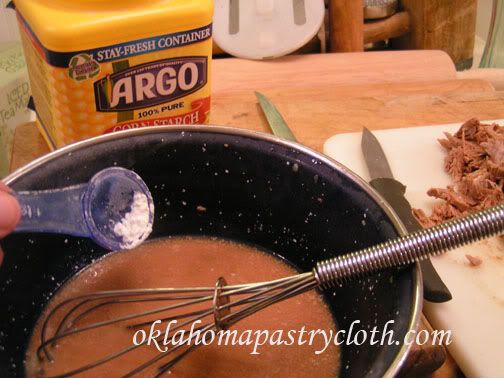 Take out a little beef stock to cool. Add some water to cool faster. Add cornstarch and blend. You can also add a tbsp of brown gravy mix if you would like for a richer flavor.  While stirring the simmering broth, add corn starch and broth mixture and stir to thicken slightly. 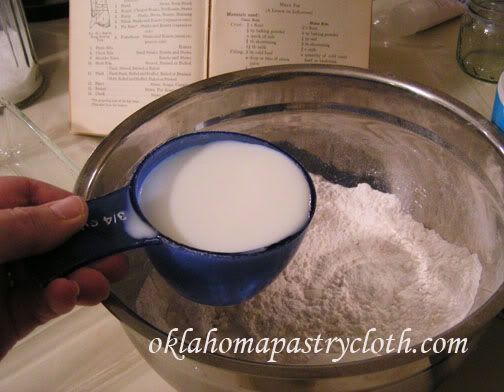 Add milk to the flour mixture and stir to form a dough ball. Add more milk if the dough is too dry. 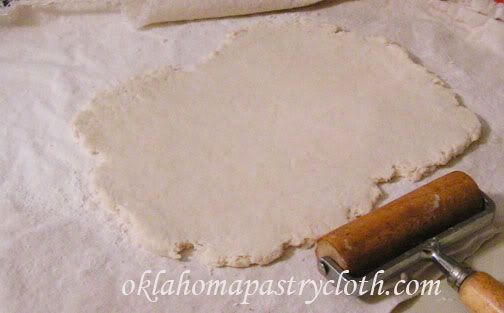 Roll the dough out into a rectangle and cut for sides leaving enough to use as a top crust. 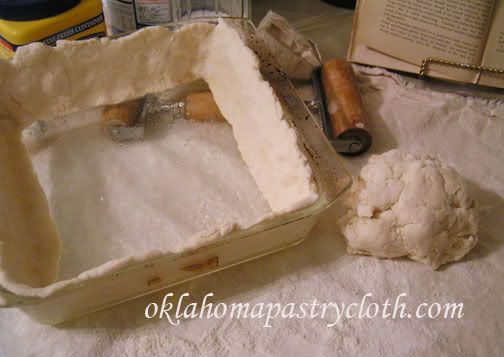 Place dough around the edges of a greased baking dish. Do not put any on the bottom 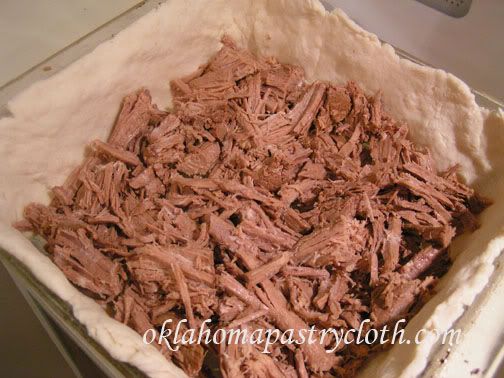 Fill the baking dish with meat 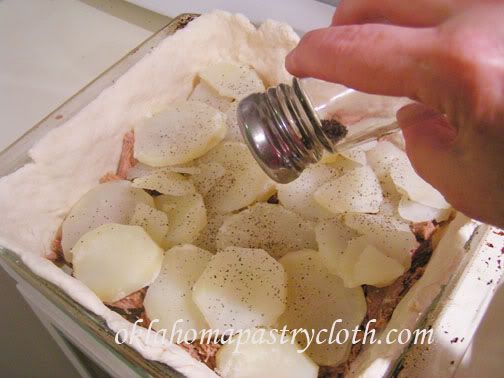 Add potatoes and salt and pepper 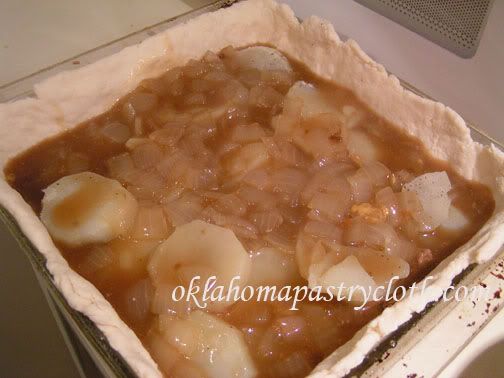 Pour the thickened broth with onions over the meat and potatoes 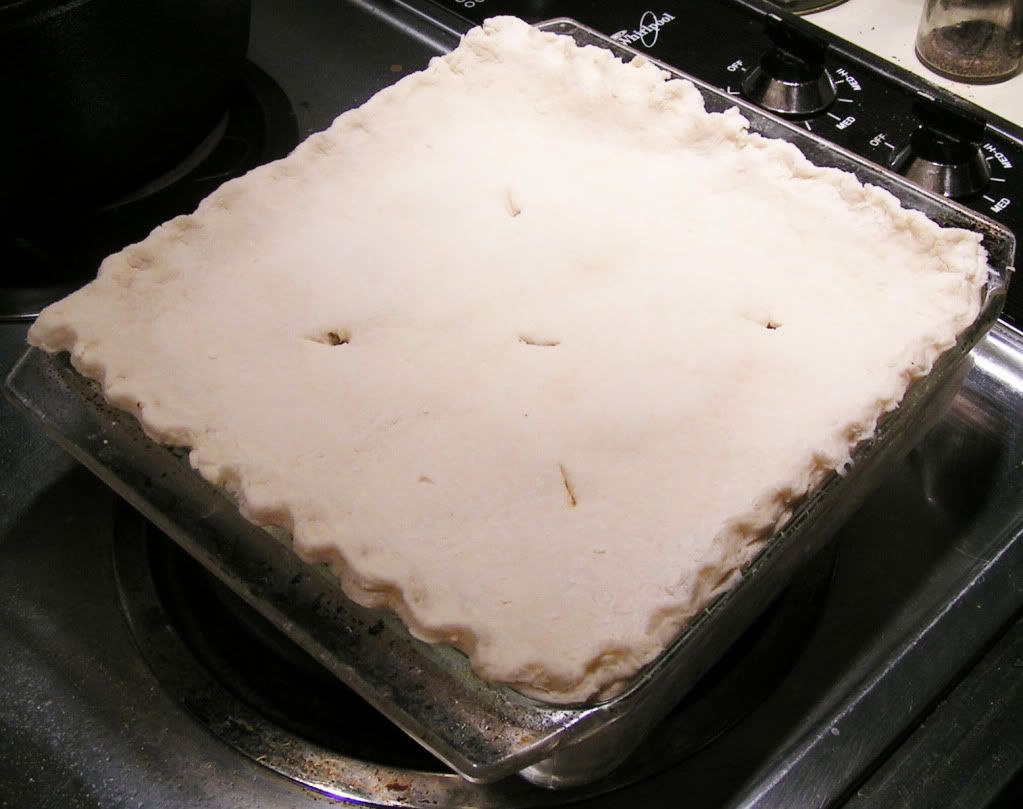 Place dough on top and crimp for appearance if you like. Make a few slits through the top of the crust. Bake at 425º for 30 – 35 minutes or until browned  The crust browns nicely for an appetizing pie 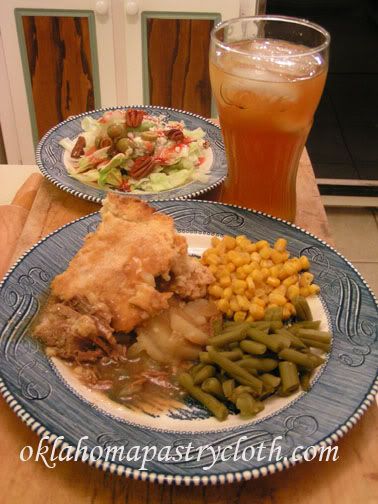 Serve with salad and veggies and you’re right back into the early 1900’s!! Happy Vintage Cooking!  |
|
|
Oklahoma Pastry Cloth™ Company on Facebook
|
|
 |
|
|
Vintage Cooking Pt. III
Monday, January 16th, 2012
 I have been doing a series of posts from my grandmother’s high school, 1914 edition of “Domestic Science” and visualizing working in a vintage kitchen with wood cook stove and Seller’s or Boone kitchen cabinet complete with sifter and flour drawers. Included in each lesson have been etiquette rules that follow each recipe in the book. Many of these rules have been passed on to the children of today, (I hope!!) but there is one issue of etiquette that I know they did not consider back then. That rule concerns the public use of cell phones.  Friday, I was sitting in the waiting room of a certain preventative testing clinic for women, minding my own business and not really caring about anybody else’s, when the woman sitting across from me accepted a call on a cell phone that was playing some really annoying jingle. She was on oxygen and so her conversation was a series of loud words stilted by the short gasps of her oxygen machine. In a voice equal to what we used to call an “outdoor voice” she carried on a conversation with the person on the other end and gave all of us in the room the inside scoop of what she was planning for the day. Meanwhile, the cellphone of the women to my left and right simultaneously whined different songs and both women loudly answered, “Hello?” Then the woman to my left said, “You’re going on a cruise?! When are you leaving? Alrighty! They kind of keep everything in and she’s the one asking about the birds and she’s just going to snap. I’m at the place to get a mammogram.” Oh my. That word and the picture it paints. Is nothing secret anymore? All three women continued to converse in mucho decibels when the Latino man across the room, waiting on his wife, made a call and in Spanish yelled over the other voices to explain something. I caught “Mañana” and “ocho” but that was the extent of my eavesdropping since the only other language I know is French. The other bored husband in the room accepted a call, about that time, and made an order for decking and something else in frustrated tones. But it was when the lady to my right took it up a notch and put her phone comrade on speaker phone that I almost lost it in gails of laughter at how ridiculous this situation was. I couldn’t hear myself think and it amazed me that these people could concentrate on what they were saying with all of the other conversations going on. I stifled a giggle as this woman said, “Oh, you know. She told us that her father kicked her out, but I found out that was a lie. I think she must be drinking.” (we REALLY needed to know that!) And the lady on the other end squawked out a reply. But I guess the fact that I was taking notes by that time, thinking, “Blog material!!”, that I got noticed because the speaker phone got cut off quickly. My name was called at that point and I sauntered into the tiny dressing room, still snickering at the sitcom into which I had just been dumped. I sat to wait my turn because I was in that place to get a you-know-what (I still have Victorian limits). A muffled voice came through from the dressing room next door, “Oh I know!! You should have seen what she made. She didn’t do it the way she was supposed to, but it turned out cute. Looks like snowflakes. I’ll show it to you tomorrow.” I had to smile at that one. Obviously a young mother or a grandmother proud of her little daughter or granddaughter. And so, before I move on to the next vintage recipe, which is to die for, by the way, I will insert a modern code of manners into the mix by reminding all that while we like to stay connected, there is a limit to that connection when it comes to public places. Those around us really don’t care about our personal lives – unless they are robbers who are taking down your plans. There is a reason for texting!! Mr. Fix-It insisted that I try this recipe next. Oh my gosh. Incredible doesn’t even come close. As I looked at the amount of chocolate used, I thought that it couldn’t be enough. I realize that back then, chocolate was really, really special and expensive and so I upped the amount a tad. Also, while I am including the original hard sauce recipe, I decided to use MY hard sauce recipe that’s a bit – harder – shall we say? Yes, it has rum in it, but it’s cooked and it made an already wonderful dessert, something to brag about. Here you go: 2 cups dried bread crumbs or 4 slices 3/4″ thick bread, dried and sliced 4 tblsp butter (1/2 stick) 3 cups scalded milk 2/3 cup sugar 1/4 cup melted chocolate (I used 1/3 cup chocolate chips) 2 eggs 1/2 tsp salt 1 tsp vanilla dash of cinnamon Hard Sauce 1/3 cup butter 1 c powdered sugar 2/3 tsp vanilla Sauce Directions: 1. Melt and cream the butter thoroughly. 2. Very gradually add the sugar, creaming constantly. Add the flavoring and set aside to cool. My Hard Sauce 1 stick butter 1 cup sugar 1 egg beaten 1/8 tsp vanilla 1/2 to 1 jigger of rum according to taste Directions and photos to follow..  Melt butter in a skillet. 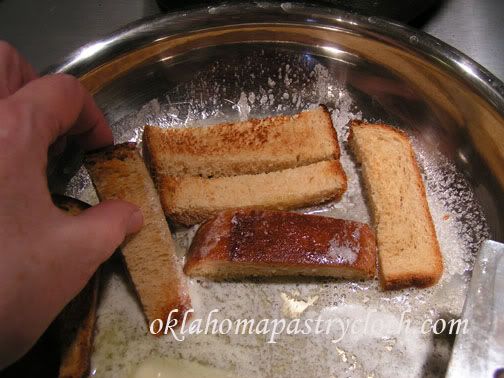 Dredge bread crumbs or sides of bread stips in the butter until all butter is gone. Note: I am using homemade whole wheat bread here. I toasted 4 thick pieces, sliced and then put in the oven on 200º for about 30 minutes to dry it out. This really made a good pudding because the bread has such body. And you can convince yourself that this is healthy because there is fiber?! 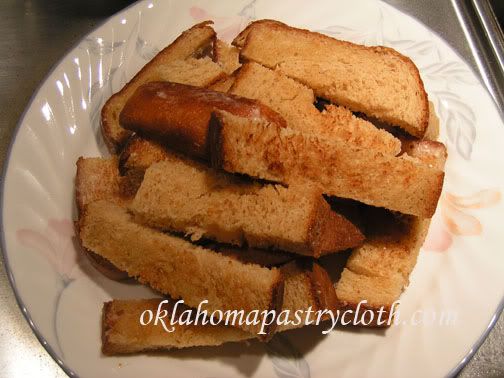 Place the bread on a plate and set aside 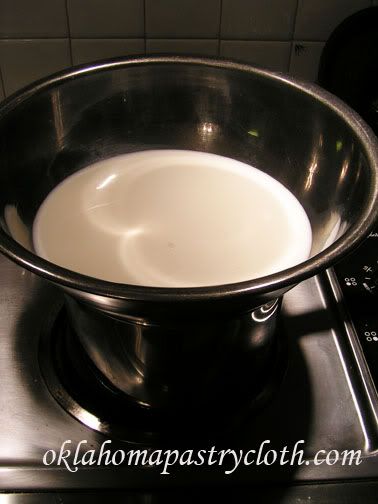 In a large double boiler (mine is too small so a stainless steel bowl over a pan of boiling water works great) pour the milk and scald to just under boiling.  Pour bread into milk and allow to soak until bread is soft. 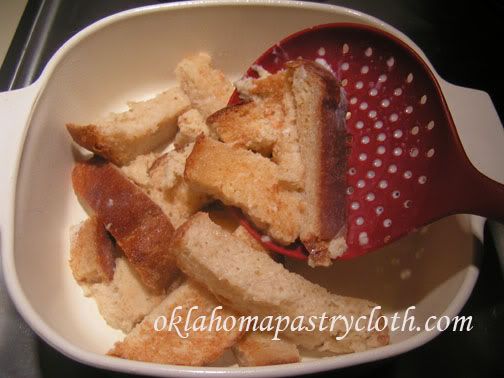 The directions say to spoon the bread into a buttered or greased ‘pudding dish’, but I looked up what that would be and I do not have one. It is made of ceramic or pottery and can be either oval or round and has a design on the bottom. So, I used the tried and true Corningware casserole dish! I sprayed my dish with spray olive oil. 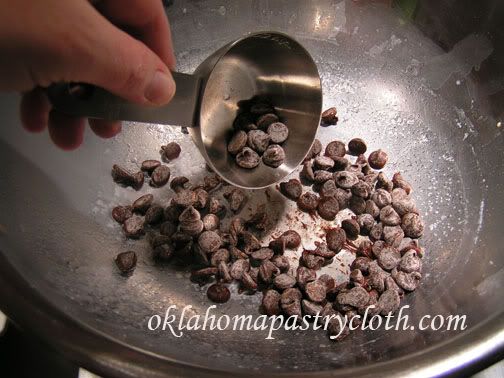 Pour leftover milk into a bowl and set aside. Place chocolate into the bowl.  Melt chocolate or chocolate chips in the bowl over boiling water.  Add just enough of the scalded milk to the melted chocolate to blend into a smooth mixture.  Add rest of the milk and blend. Add dash of cinnamon. 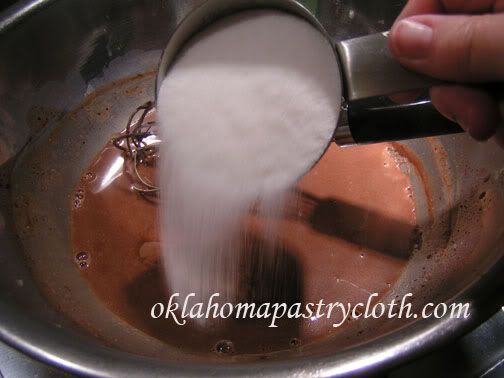 Add half the sugar and blend 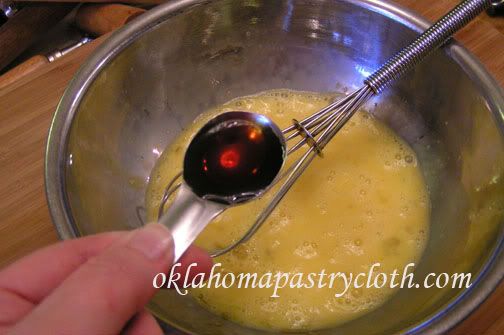 In another bowl, beat two eggs and add salt, sugar and the rest of the sugar and beat until creamy 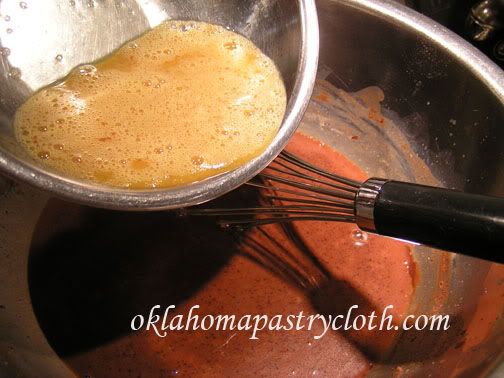 Gently pour, little by little, the egg mixture into the chocolate mixture whisking continually to keep the eggs from curdling. Stir until the mixture is smooth. 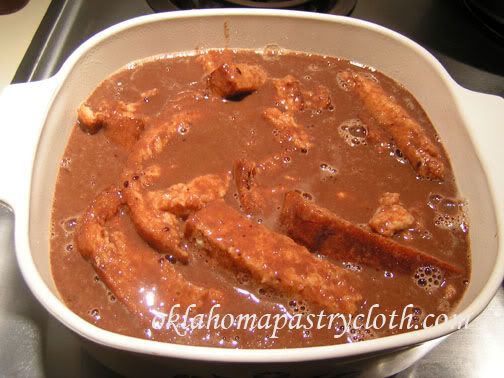 Pour chocolate mixture over bread pieces in the baking dish. Now this is where I had to do some guessing because it said, “Bake in a moderate oven until done.” I figured 350º for 45 minutes. That worked great. I have to remember with these recipes that the old stoves were more of a guess than a thermostat! 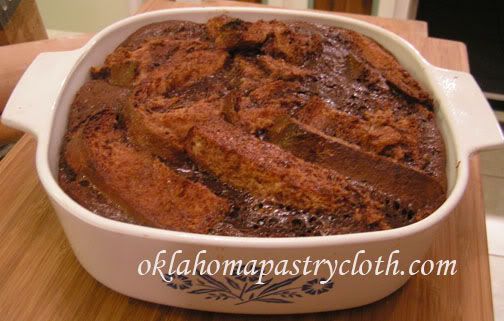 Test with a sharp knife or toothpick to come out clean. Allow to stand for a few minutes. The sides of the pudding will pull away from the sides of the dish. Serve warm with warm hard sauce that follows. 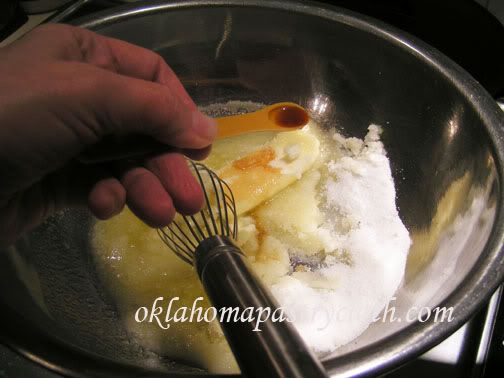 In a clean bowl over boiling water, or in a small double boiler, melt butter and add sugar and vanilla. 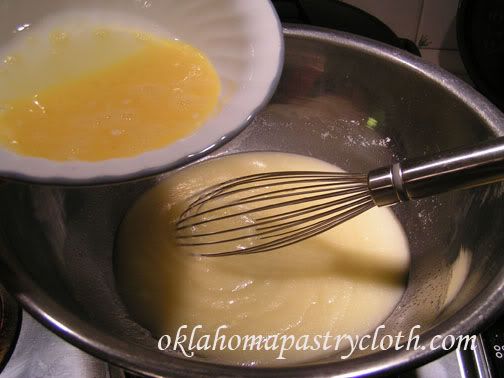 Stir until mixture is smooth and then gently add beaten egg, whisking continually to keep the egg from curdling. 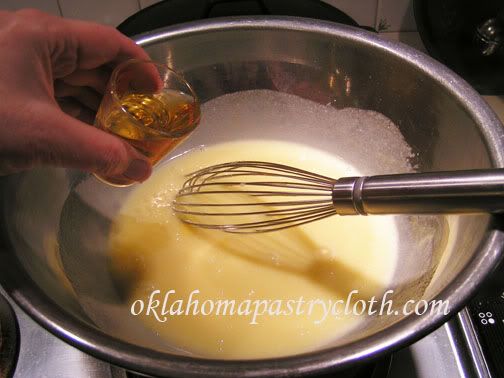 Add rum and stir.  Cook for about 10 minutes until sugar is completely dissolved and sauce is thick and smooth  Spoon each serving of warm chocolate bread pudding in a bowl and ladle sauce over it. I promise, you will sit there and just sigh with joy. Leftovers of both sauce and pudding may be reheated. Table Manners:
Happy Desserting!  |
|
|
Oklahoma Pastry Cloth™ Company on Facebook
|
|
 |
|
|
Vintage Cooking Pt 2
Thursday, January 12th, 2012
 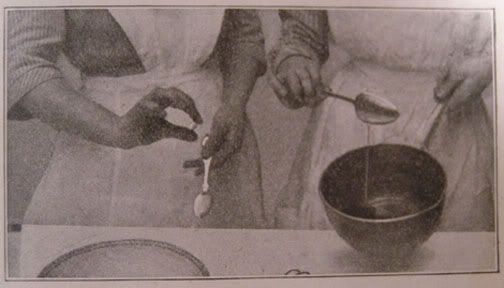 I’m really having fun going through my grandmother’s “Domestic Science Books I and II” book. Having been published in 1914, you can imagine the photos of women in their sleeved, long dresses and taylored, floor-length, white aprons, primly tied at tiny waists. I feel very happy to see that my short, work-worn fingernails look exactly like theirs. Evidently, women, back then, didn’t worry about French tips or painted designs on their fingernails, either. At the beginning of book II of this wonderful home living manual, I came across the following poem, by Owen Meredith. It is so ridiculous, I have to post it. Obviously, this Owen guy would have benefitted from today’s Overeater’s Anonymous. He seems to have been so focused on eating that all else was trivial to him! You be the judge: O hour of all hours, the most bless’d upon earth, Blessed hour of our dinners! * We may live without poetry, music, and art, We may live without conscience, and live without heart; We may live without friends; we may live without books; But civilized man cannot live without cooks. He may live without books – what is knowledge but grieving? He may live without hope – what is hope but deceiving? He may live without love – what is passion but pining? But where is the man that can live without dining? – Owen Meredith Makes you hungry, huh? Well, I’ll solve that problem and share another lesson in recipe from days gone by, which would be easy to cook on your wood cook stove! You can pretend! I will be giving the recipe for their dumplings, which are the type that are fluffy and soft. We southerners like flat dumplings or oval ones that are more like noodle dough. And so, while I’ll give you the recipe the book suggests, I’ll show you the pictures and recipe for the dumplings that I make. And of course, at the end, just as in the book, I’ll post those rules for table manners ala 1914. So stoke up the fire…. 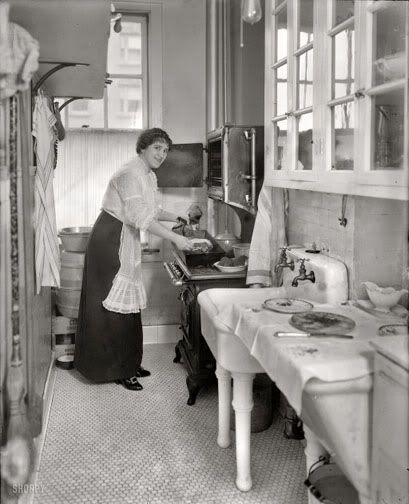 3 lbs beef – preferably round roast 1 tblsp butter 2 tblsp flour 2 onions sliced 1 carrot 4 potatoes water or beef stock salt and pepper 1 turnip (optional) Dumplings 2 cups flour 4 tsp baking powder 1 tsp salt 3/4 cup water or milk Sift the dry ingredients together; add the liquid gradually. Drop by the spoonful upon the stew and cook until done. 1 cup all-purpose flour 1 egg 1 tsp baking powder 1/4 cup water or milk 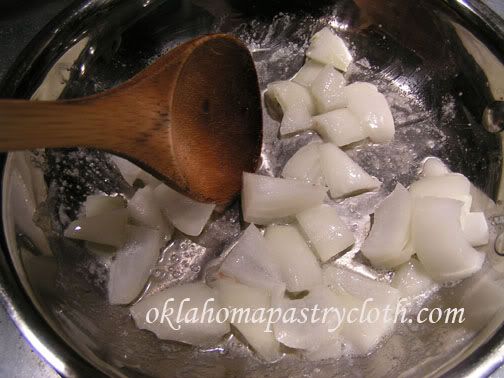 Cut the roast into 1″ cubes and toss meat in flour. I used my canned rump roast (what can I say? Rump roast was on sale, cheap!) and cubed that. Sauté onions in butter and add beef to brown. 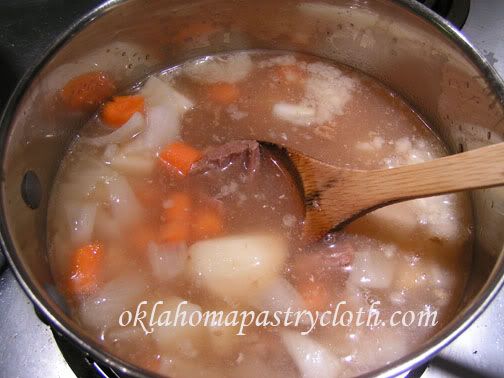 Add water or beef stock (I used stock) and simmer for at least an hour to an hour and a half until meat is tender. Add chopped carrots, potatoes and chopped turnip (optional) and cook 45 minutes longer. 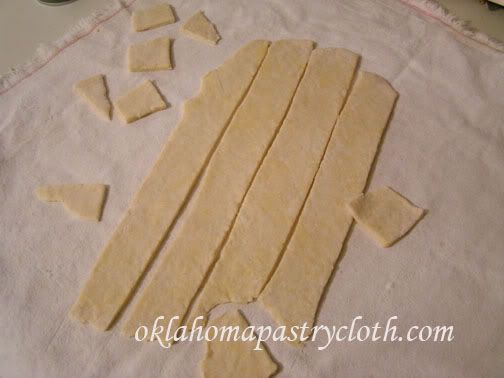 Mix ingredients together for dumplings, using just enough water to form a dough ball. Roll out onto your Oklahoma Pastry Cloth™ and slice in 1″ strips. Slice strips across to form 1″ squares. 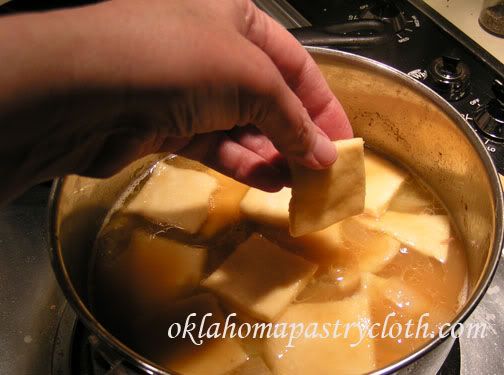 Bring stew to a boil and place dumplings on top of broth.  With spoon, gently press dumplings into broth to cover. Simmer for 20 minutes until tender. 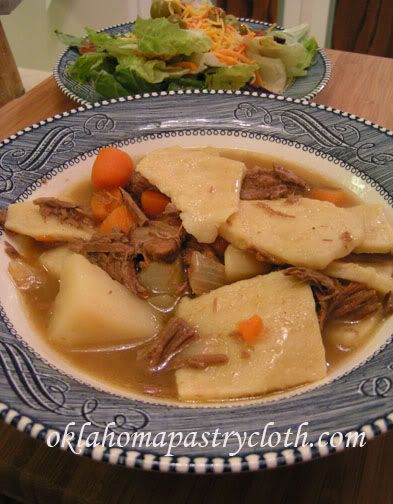 Serve with salad and cornbread or fresh bread and dig in. It’s simple! Table manners: Do not hold the knife and fork upright on the table. The knife and fork when used for cutting should be held with the fork, tines down, in the left hand and the knife in the right hand, the handles in the hollows of the hands. Do not open the mouth to receive food until the food reaches the mouth. Always eat or sip from the side of the spoon. The napkin should never be tucked in the collar. Happy Vintage Cooking!  |
|
|
Oklahoma Pastry Cloth™ Company on Facebook
|
|
 |
|
|
Vintage Cooking Pt 1
Monday, January 9th, 2012
 Some call it “pretending” but I like to call it “supposin’ ” when, every so often, I whisk myself back (in my mind of course) to the late 1800’s and early 1900’s wondering what it would be like to do back then, what I am doing at that moment. For example, in 1992 I broke my leg and ankle in five places and as I lay on the couch with leg encased in plaster of Paris, elevated and throbbing, I immersed myself in a book entitled ‘And Ladies of the Club’. Transported back into the time of the Civil War and then the Victorian age, I read that my situation would have been quite dire indeed. Instead of a cast, I would have had my leg cut off and could have died of gangrene. Lovely. Made me appreciate 1992 all the more! But I do see the good of those eras with the slower way of life and simpler way of doing things. It is an encouragement for us to slow down and simplify as well.  Awhile back, I posted an account about my parents’ life-changing move to a retirement community. The process was emotional for all of us because of the sale of their home and their move to another state. But going through all of the boxes holding their nearly 62 years of marriage, passed on to each of us four girls and our children, was bittersweet indeed. One of my boxes held a number of very old cookbooks. My parents know me well! Some of these books are just amazing and precious. The oldest one and truly my most precious of cookbooks, is the 1914 first edition, high school textbook for Austin’s Domestic Science (we called it Home Ec) inscribed with the perfect penmanship of my Grandmother Johnson, then Margaret Allen, Class IC – my mother’s mother. Recipes recorded by her with an inkwell and pen, obviously lessons from class, cover pages nestled between tiny print of early 1900’s etiquette, rules, ingredients and recipe lessons. The book is a treasure, as are some of the others, and I thought that I would do a series of posts using a few of the vintage recipes, instructions and lessons in etiquette. Skimming the book, my eyes fell on the title, “Hamburg Steak”, and immediately, I decided to make that my first endeavor. I’ll give you three guesses what is Hamburg Steak! The recipe was brought to America by German immigrants where Hamburg Steak was a meal of the poorer classes. It wasn’t until 1916, two years after this textbook was published, that the Hamburger Bun was introduced by a fry cook named Walter Anderson, who co-founded White Castle in 1921. I have to tell you that I did not think this recipe was going to be all that great, but Mr. Fix-It loved it and asked for the leftovers the next day!  I had to consider the fact that most people did not buy freshly ground meat in 1914 and so the instructions in the recipe to purchase round steak, to remove the bone and gristle and to cube and grind in the hand grinder should be no surprise. I, however, DO buy ground meat today and so I skipped that process even though I have a hand grinder, have capable shoulders and used to grind meat as a butcher’s assistant! There is only so much “supposin’ ” I’m willing to initiate these days. Anyway, I wonder if they called it Ground Round back then. I was struck that most of the beef recipes in the book called for either round steak, ground, or round roast, sliced or whole. Evidently, that was the cut of meat most popular. It totally explains to me why mother, when first married and with very little money, stunned my father when she brought home the expensive ground round from the store. She says that her mother only served ground round, and never any of the cheaper ground meats, so she did not know there were any other types of ground meat. Obviously, Grandmother had learned well about her meats in Class IC of Domestic Science! So fire up your 1914 wood stoves (or if you were rich, the newly introduced fancy gas stove) and get out your cast iron skillet. The recipe is simple and really yummy. Be sure and note the etiquette rule about your after dinner coffee or tea at the end. 1 tablespoon finely chopped onion 1/2 teaspoon salt 1 egg dash of pepper 1 lb round steak, boned, cut into cubes and run through a meat grinder (1 lb ground round y’all) Gravy: 2 tbsp butter 2 tbsp flour 1 cup beef broth  Add finely chopped onions to ground meat 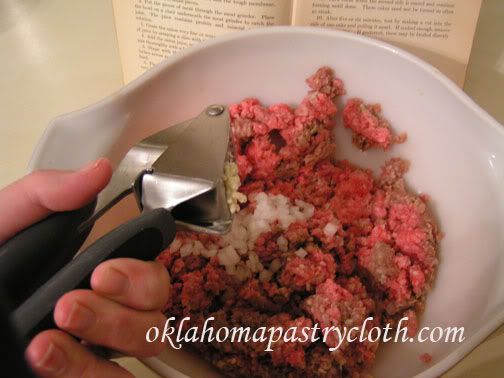 The recipe did not call for garlic, but I have to have my garlic and I think that it made a huge addition. Either chop or press your galic clove. 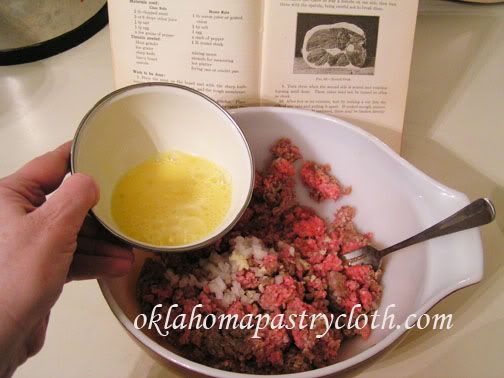 Add beaten egg 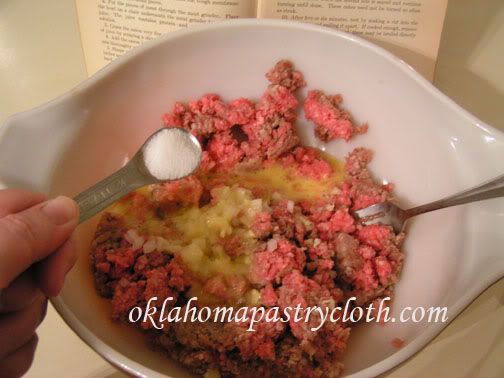 Add salt 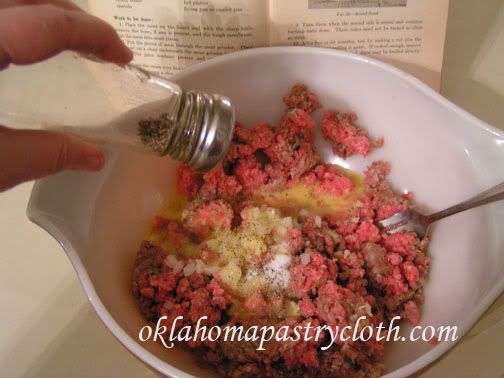 And pepper 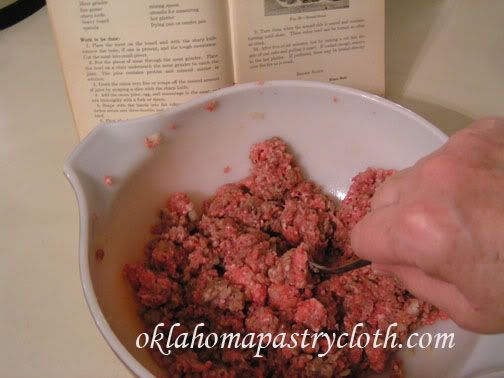 Mix ingredients until well incorporated 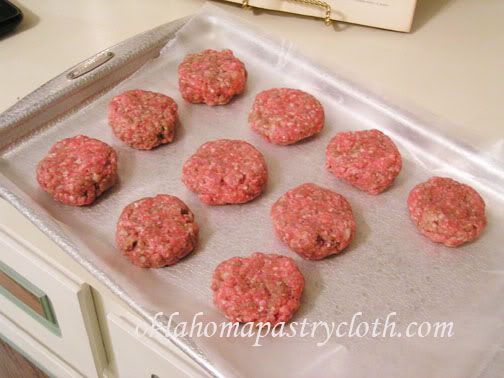 The recipe called to form into patties 1 1/2″ in diameter and 3/4″ thick, but I think mine were more 2 1/2″ diameter and 3/4″ thick.  Add tblsp of butter to a heavy skillet on high heat and spread across the surface to oil. Place patties into the skillet to sear for about 30 seconds. Turn and sear on the other side and reduce heat to medium. Continue to turn patties until cooked all the way through. Do not press them or pierce them because the juices are trapped inside and make the patties tender and tasty. 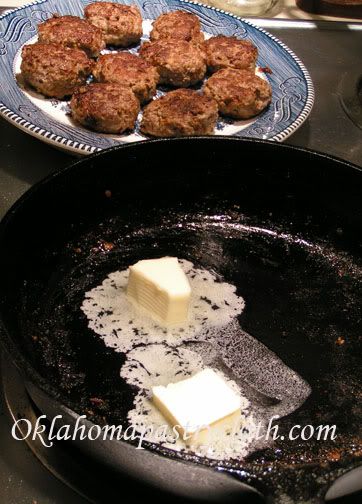 Remove patties to a warming plate to keep warm. Wipe skillet lightly to remove beef fat and add two tblsps butter to melt on medium heat. 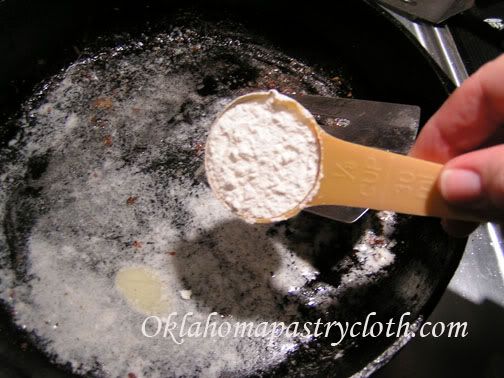 Add flour 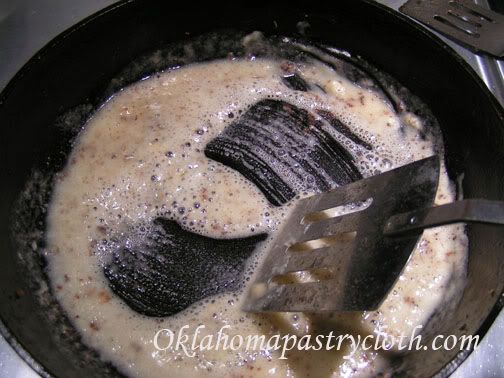 and stir quickly to form a ‘roue’ 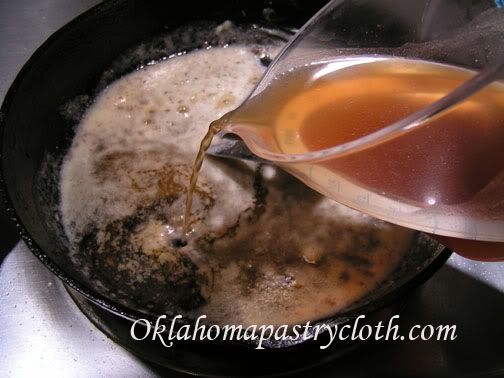 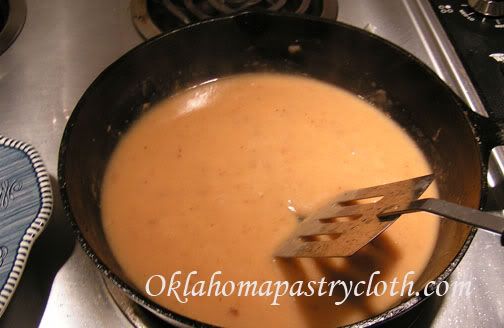 Pour in beef stock and stir to form a gravy. 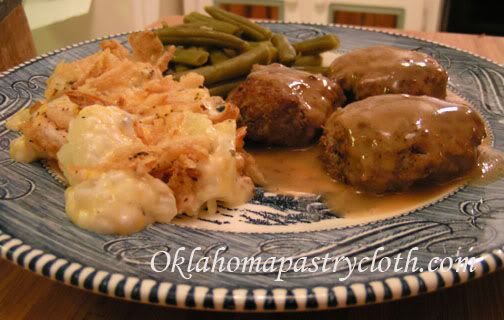 Served with au gratin potatoes, green beans and fresh bread, this meal made Mr. Fix-It very happy! The following is an etiquette lesson from the book that all should know for sure!!  Austin’s Domestic Science Book One and Two, page 170: “At a formal dinner, very strong coffee is made and served without cream, but with or without sugar as the individual prefers. Such coffee is called café noir, or black coffee. It is served in very small coffee cups, or after-dinner coffee cups. When cream and sugar are served with coffee, many think the flavor of the coffee is improved if they are placed in the cup before the coffee is poured in. TABLE MANNERS: Coffee, tea and cocoa should be drunk from the cup. The spoon is used to stir coffee or tea and sip it in order to ascertain if the flavor is right, but should not be otherwise used with coffee or tea. It seems unnecessary to state that these beverages are never to be drunk from the saucer.” Happy Vintage Cooking!  |
|
|
Oklahoma Pastry Cloth™ Company on Facebook
|
|
 |
|
|

 Homestead Revival
Homestead Revival Paratus Familia
Paratus Familia Rural Revolution
Rural Revolution